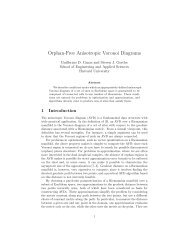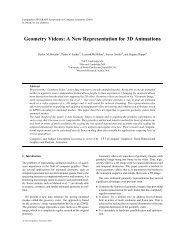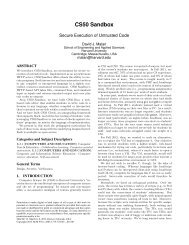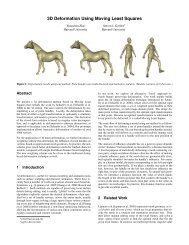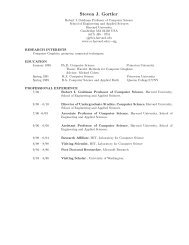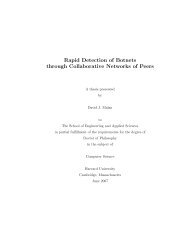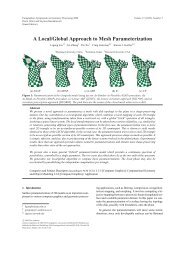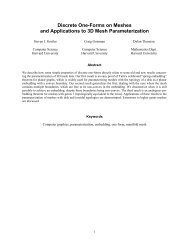A Public-Key Infrastructure for Key Distribution in TinyOS Based on ...
A Public-Key Infrastructure for Key Distribution in TinyOS Based on ...
A Public-Key Infrastructure for Key Distribution in TinyOS Based on ...
You also want an ePaper? Increase the reach of your titles
YUMPU automatically turns print PDFs into web optimized ePapers that Google loves.
A <str<strong>on</strong>g>Public</str<strong>on</strong>g>-<str<strong>on</strong>g>Key</str<strong>on</strong>g> <str<strong>on</strong>g>Infrastructure</str<strong>on</strong>g> <str<strong>on</strong>g>for</str<strong>on</strong>g> <str<strong>on</strong>g>Key</str<strong>on</strong>g> <str<strong>on</strong>g>Distributi<strong>on</strong></str<strong>on</strong>g> <str<strong>on</strong>g>in</str<strong>on</strong>g> T<str<strong>on</strong>g>in</str<strong>on</strong>g>yOS<br />
<str<strong>on</strong>g>Based</str<strong>on</strong>g> <strong>on</strong> Elliptic Curve Cryptography<br />
David J. Malan, Matt Welsh, Michael D. Smith<br />
Divisi<strong>on</strong> of Eng<str<strong>on</strong>g>in</str<strong>on</strong>g>eer<str<strong>on</strong>g>in</str<strong>on</strong>g>g and Applied Sciences<br />
Harvard University<br />
{malan,mdw,smith}@eecs.harvard.edu<br />
Abstract— We present the first known implementati<strong>on</strong> of elliptic<br />
curve cryptography over F 2 p <str<strong>on</strong>g>for</str<strong>on</strong>g> sensor networks based <strong>on</strong><br />
the 8-bit, 7.3828-MHz MICA2 mote. Through <str<strong>on</strong>g>in</str<strong>on</strong>g>strumentati<strong>on</strong> of<br />
UC Berkeley’s T<str<strong>on</strong>g>in</str<strong>on</strong>g>ySec module, we argue that, although secret-key<br />
cryptography has been tractable <str<strong>on</strong>g>in</str<strong>on</strong>g> this doma<str<strong>on</strong>g>in</str<strong>on</strong>g> <str<strong>on</strong>g>for</str<strong>on</strong>g> some time,<br />
there has rema<str<strong>on</strong>g>in</str<strong>on</strong>g>ed a need <str<strong>on</strong>g>for</str<strong>on</strong>g> an efficient, secure mechanism<br />
<str<strong>on</strong>g>for</str<strong>on</strong>g> distributi<strong>on</strong> of secret keys am<strong>on</strong>g nodes. Although public-key<br />
<str<strong>on</strong>g>in</str<strong>on</strong>g>frastructure has been thought impractical, we argue, through<br />
analysis of our own implementati<strong>on</strong> <str<strong>on</strong>g>for</str<strong>on</strong>g> T<str<strong>on</strong>g>in</str<strong>on</strong>g>yOS of multiplicati<strong>on</strong><br />
of po<str<strong>on</strong>g>in</str<strong>on</strong>g>ts <strong>on</strong> elliptic curves, that public-key <str<strong>on</strong>g>in</str<strong>on</strong>g>frastructure is, <str<strong>on</strong>g>in</str<strong>on</strong>g><br />
fact, viable <str<strong>on</strong>g>for</str<strong>on</strong>g> T<str<strong>on</strong>g>in</str<strong>on</strong>g>ySec keys’ distributi<strong>on</strong>, even <strong>on</strong> the MICA2. We<br />
dem<strong>on</strong>strate that public keys can be generated with<str<strong>on</strong>g>in</str<strong>on</strong>g> 34 sec<strong>on</strong>ds,<br />
and that shared secrets can be distributed am<strong>on</strong>g nodes <str<strong>on</strong>g>in</str<strong>on</strong>g> a sensor<br />
network with<str<strong>on</strong>g>in</str<strong>on</strong>g> the same, us<str<strong>on</strong>g>in</str<strong>on</strong>g>g just over 1 kilobyte of SRAM and<br />
34 kilobytes of ROM.<br />
I. INTRODUCTION<br />
Wireless sensor networks have been proposed <str<strong>on</strong>g>for</str<strong>on</strong>g> such applicati<strong>on</strong>s<br />
as habitat m<strong>on</strong>itor<str<strong>on</strong>g>in</str<strong>on</strong>g>g [1], structural health m<strong>on</strong>itor<str<strong>on</strong>g>in</str<strong>on</strong>g>g<br />
[2], emergency medical care [3], and vehicular track<str<strong>on</strong>g>in</str<strong>on</strong>g>g [4],<br />
all of which demand some comb<str<strong>on</strong>g>in</str<strong>on</strong>g>ati<strong>on</strong> of authenticati<strong>on</strong>,<br />
<str<strong>on</strong>g>in</str<strong>on</strong>g>tegrity, privacy, and security. Un<str<strong>on</strong>g>for</str<strong>on</strong>g>tunately, the state of the<br />
art has offered weak, if any, guarantees of these needs.<br />
The limited resources boasted by today’s sensor networks<br />
appear to render them ill-suited <str<strong>on</strong>g>for</str<strong>on</strong>g> the most straight<str<strong>on</strong>g>for</str<strong>on</strong>g>ward<br />
implementati<strong>on</strong>s of security protocols. C<strong>on</strong>sider the MICA2<br />
mote [5], designed by researchers at the University of Cali<str<strong>on</strong>g>for</str<strong>on</strong>g>nia<br />
at Berkeley and fabricated by Crossbow Technology,<br />
Inc. This device offers an 8-bit, 7.3828-MHz ATmega 128L<br />
processor, 4 kilobytes (KB) of primary memory (SRAM), and<br />
128 KB of program space (ROM). Such a device, given these<br />
resources, is seem<str<strong>on</strong>g>in</str<strong>on</strong>g>gly unfit <str<strong>on</strong>g>for</str<strong>on</strong>g> computati<strong>on</strong>ally expensive<br />
or energy-<str<strong>on</strong>g>in</str<strong>on</strong>g>tensive operati<strong>on</strong>s. For this reas<strong>on</strong> has publickey<br />
cryptography often been ruled out <str<strong>on</strong>g>for</str<strong>on</strong>g> sensor networks<br />
as an <str<strong>on</strong>g>in</str<strong>on</strong>g>frastructure <str<strong>on</strong>g>for</str<strong>on</strong>g> authenticati<strong>on</strong>, <str<strong>on</strong>g>in</str<strong>on</strong>g>tegrity, privacy, and<br />
security [6]–[9], even despite its allowance <str<strong>on</strong>g>for</str<strong>on</strong>g> secure rekey<str<strong>on</strong>g>in</str<strong>on</strong>g>g<br />
of mobile devices.<br />
But such c<strong>on</strong>clusi<strong>on</strong>s have been backed too <str<strong>on</strong>g>in</str<strong>on</strong>g>frequently<br />
by actual data. In fact, to our knowledge, little empirical<br />
research has been published <strong>on</strong> the viability of public-key<br />
<str<strong>on</strong>g>in</str<strong>on</strong>g>frastructure (PKI) <str<strong>on</strong>g>for</str<strong>on</strong>g> the MICA2, save <str<strong>on</strong>g>for</str<strong>on</strong>g> a cursory analysis<br />
of an implementati<strong>on</strong> of RSA [10] and a recent comparis<strong>on</strong> of<br />
RSA and elliptic curve cryptography (ECC) over F p [11].<br />
Our work aspires to fill this void. Through <str<strong>on</strong>g>in</str<strong>on</strong>g>strumentati<strong>on</strong><br />
of T<str<strong>on</strong>g>in</str<strong>on</strong>g>yOS, we first dem<strong>on</strong>strate that secret-key cryptography is<br />
tractable <strong>on</strong> the MICA2. By way of our own implementati<strong>on</strong><br />
of multiplicati<strong>on</strong> of po<str<strong>on</strong>g>in</str<strong>on</strong>g>ts <strong>on</strong> elliptic curves, we then argue<br />
that PKI <str<strong>on</strong>g>for</str<strong>on</strong>g> secret keys’ distributi<strong>on</strong> is, <str<strong>on</strong>g>in</str<strong>on</strong>g> fact, tractable as<br />
well. <str<strong>on</strong>g>Public</str<strong>on</strong>g> keys can be generated with<str<strong>on</strong>g>in</str<strong>on</strong>g> 34 sec<strong>on</strong>ds (sec),<br />
and shared secrets can be distributed with<str<strong>on</strong>g>in</str<strong>on</strong>g> the same, us<str<strong>on</strong>g>in</str<strong>on</strong>g>g<br />
just over 1 KB of SRAM and 34 KB of ROM.<br />
We beg<str<strong>on</strong>g>in</str<strong>on</strong>g> these arguments <str<strong>on</strong>g>in</str<strong>on</strong>g> Secti<strong>on</strong> II with an analysis<br />
of T<str<strong>on</strong>g>in</str<strong>on</strong>g>ySec [6], T<str<strong>on</strong>g>in</str<strong>on</strong>g>yOS’s exist<str<strong>on</strong>g>in</str<strong>on</strong>g>g secret-key <str<strong>on</strong>g>in</str<strong>on</strong>g>frastructure <str<strong>on</strong>g>for</str<strong>on</strong>g><br />
the MICA2 based <strong>on</strong> SKIPJACK [12]. In Secti<strong>on</strong> III, we<br />
address shortcom<str<strong>on</strong>g>in</str<strong>on</strong>g>gs <str<strong>on</strong>g>in</str<strong>on</strong>g> that <str<strong>on</strong>g>in</str<strong>on</strong>g>frastructure with a look at an<br />
implementati<strong>on</strong> of Diffie-Hellman <str<strong>on</strong>g>for</str<strong>on</strong>g> the MICA2 based <strong>on</strong><br />
the Discrete Logarithm Problem (DLP) and expose weaknesses<br />
<str<strong>on</strong>g>in</str<strong>on</strong>g> its design <str<strong>on</strong>g>for</str<strong>on</strong>g> sensor networks. In Secti<strong>on</strong> IV, we<br />
redress those weaknesses with our own implementati<strong>on</strong> of<br />
Diffie-Hellman based <strong>on</strong> the Elliptic Curve Discrete Logarithm<br />
Problem (ECDLP). In Secti<strong>on</strong> V, we discuss optimizati<strong>on</strong>s<br />
underly<str<strong>on</strong>g>in</str<strong>on</strong>g>g our implementati<strong>on</strong>. In Secti<strong>on</strong> VI, we propose<br />
directi<strong>on</strong>s <str<strong>on</strong>g>for</str<strong>on</strong>g> future work, while, <str<strong>on</strong>g>in</str<strong>on</strong>g> Secti<strong>on</strong> VII, we explore<br />
related work. We c<strong>on</strong>clude <str<strong>on</strong>g>in</str<strong>on</strong>g> Secti<strong>on</strong> VIII.<br />
II. SKIPJACK AND THE MICA2<br />
T<str<strong>on</strong>g>in</str<strong>on</strong>g>yOS currently offers the MICA2 access c<strong>on</strong>trol, authenticati<strong>on</strong>,<br />
<str<strong>on</strong>g>in</str<strong>on</strong>g>tegrity, and c<strong>on</strong>fidentiality through T<str<strong>on</strong>g>in</str<strong>on</strong>g>ySec, a l<str<strong>on</strong>g>in</str<strong>on</strong>g>klayer<br />
security mechanism based <strong>on</strong> SKIPJACK <str<strong>on</strong>g>in</str<strong>on</strong>g> cipher-block<br />
cha<str<strong>on</strong>g>in</str<strong>on</strong>g><str<strong>on</strong>g>in</str<strong>on</strong>g>g mode. An 80-bit symmetric cipher, SKIPJACK is the<br />
<str<strong>on</strong>g>for</str<strong>on</strong>g>merly classified algorithm beh<str<strong>on</strong>g>in</str<strong>on</strong>g>d the Clipper chip, approved<br />
by the Nati<strong>on</strong>al Institute <str<strong>on</strong>g>for</str<strong>on</strong>g> Standards and Technology (NIST)<br />
<str<strong>on</strong>g>in</str<strong>on</strong>g> 1994 <str<strong>on</strong>g>for</str<strong>on</strong>g> the Escrowed Encrypti<strong>on</strong> Standard [13]. T<str<strong>on</strong>g>in</str<strong>on</strong>g>ySec<br />
supports message authenticati<strong>on</strong> and <str<strong>on</strong>g>in</str<strong>on</strong>g>tegrity with message authenticati<strong>on</strong><br />
codes, c<strong>on</strong>fidentiality with encrypti<strong>on</strong>, and access<br />
c<strong>on</strong>trol with shared, group keys.<br />
The mechanism allows <str<strong>on</strong>g>for</str<strong>on</strong>g> an 80-bit key space, the benefit<br />
of which is that known attacks require as many 2 79 operati<strong>on</strong>s<br />
<strong>on</strong> average (assum<str<strong>on</strong>g>in</str<strong>on</strong>g>g SKIPJACK isn’t reduced from 32
ounds [14]). 1 Moreover, as packets under T<str<strong>on</strong>g>in</str<strong>on</strong>g>ySec <str<strong>on</strong>g>in</str<strong>on</strong>g>clude a<br />
4-byte message authenticati<strong>on</strong> code (MAC), the probability of<br />
bl<str<strong>on</strong>g>in</str<strong>on</strong>g>d <str<strong>on</strong>g>for</str<strong>on</strong>g>gery is <strong>on</strong>ly 2 −32 . This security comes at a cost of just<br />
five bytes (B): whereas transmissi<strong>on</strong> of some 29-byte pla<str<strong>on</strong>g>in</str<strong>on</strong>g>text<br />
and its cyclic redundancy check (CRC) requires a packet of<br />
36 B, transmissi<strong>on</strong> of that pla<str<strong>on</strong>g>in</str<strong>on</strong>g>text’s ciphertext and MAC under<br />
T<str<strong>on</strong>g>in</str<strong>on</strong>g>ySec requires a packet of <strong>on</strong>ly 41 B, as the mechanism<br />
borrows T<str<strong>on</strong>g>in</str<strong>on</strong>g>yOS’s fields <str<strong>on</strong>g>for</str<strong>on</strong>g> Group ID (T<str<strong>on</strong>g>in</str<strong>on</strong>g>yOS’s weak, default<br />
mechanism <str<strong>on</strong>g>for</str<strong>on</strong>g> access c<strong>on</strong>trol) and CRC <str<strong>on</strong>g>for</str<strong>on</strong>g> its MAC.<br />
Per<str<strong>on</strong>g>for</str<strong>on</strong>g>mance. The impact of T<str<strong>on</strong>g>in</str<strong>on</strong>g>ySec <strong>on</strong> the MICA2’s<br />
per<str<strong>on</strong>g>for</str<strong>on</strong>g>mance is reas<strong>on</strong>able. On first glance, it would appear<br />
that T<str<strong>on</strong>g>in</str<strong>on</strong>g>ySec adds under 2 millisec<strong>on</strong>ds (ms) to a packet’s<br />
transmissi<strong>on</strong> time (Table I) and under 5 ms to a packet’s roundtrip<br />
time to and from some neighbor (Table II). However,<br />
the apparent overhead of T<str<strong>on</strong>g>in</str<strong>on</strong>g>ySec, 1,244 microsec<strong>on</strong>ds (µsec)<br />
<strong>on</strong> average, as suggested by transmissi<strong>on</strong> times, is nearly<br />
subsumed by the data’s root mean square (1,094 µsec). Roundtrip<br />
times exhibit less variance, but tighter benchmarks are <str<strong>on</strong>g>in</str<strong>on</strong>g><br />
order <str<strong>on</strong>g>for</str<strong>on</strong>g> T<str<strong>on</strong>g>in</str<strong>on</strong>g>ySec’s accurate analysis.<br />
Table III, then, offers results with yet less variance from f<str<strong>on</strong>g>in</str<strong>on</strong>g>er<br />
<str<strong>on</strong>g>in</str<strong>on</strong>g>strumentati<strong>on</strong> of T<str<strong>on</strong>g>in</str<strong>on</strong>g>ySec: encrypti<strong>on</strong> of a 29-byte, random<br />
payload requires 2,190 µsec <strong>on</strong> average, and computati<strong>on</strong> of<br />
that payload’s MAC requires 3,049 µsec <strong>on</strong> average; overall,<br />
T<str<strong>on</strong>g>in</str<strong>on</strong>g>ySec adds 5,239 ± 18 µsec to a packet’s computati<strong>on</strong>al<br />
requirements. It appears, then, that some of those cycles can<br />
be subsumed by delays <str<strong>on</strong>g>in</str<strong>on</strong>g> schedul<str<strong>on</strong>g>in</str<strong>on</strong>g>g and medium access, at<br />
least <str<strong>on</strong>g>for</str<strong>on</strong>g> applicati<strong>on</strong>s not already operat<str<strong>on</strong>g>in</str<strong>on</strong>g>g at full duty. Fig. 1,<br />
the results of an analysis of the MICA2’s throughput, without<br />
and with T<str<strong>on</strong>g>in</str<strong>on</strong>g>ySec enabled, puts the mechanism’s computati<strong>on</strong>al<br />
overhead <str<strong>on</strong>g>for</str<strong>on</strong>g> such applicati<strong>on</strong>s <str<strong>on</strong>g>in</str<strong>on</strong>g>to perspective: <strong>on</strong> average,<br />
T<str<strong>on</strong>g>in</str<strong>on</strong>g>ySec may lower throughput of acknowledged packets by<br />
<strong>on</strong>ly 0.28 packets per sec<strong>on</strong>d. These results appear <str<strong>on</strong>g>in</str<strong>on</strong>g> l<str<strong>on</strong>g>in</str<strong>on</strong>g>e with<br />
UC Berkeley’s own evaluati<strong>on</strong> of T<str<strong>on</strong>g>in</str<strong>on</strong>g>ySec [15].<br />
Memory. Of course, T<str<strong>on</strong>g>in</str<strong>on</strong>g>ySec’s encrypti<strong>on</strong> and authenticati<strong>on</strong><br />
does come at an additi<strong>on</strong>al cost <str<strong>on</strong>g>in</str<strong>on</strong>g> memory. Per Table IV,<br />
T<str<strong>on</strong>g>in</str<strong>on</strong>g>ySec adds 454 B to an applicati<strong>on</strong>’s .bss segment, 276 B<br />
to an applicati<strong>on</strong>’s .data segment, 7,076 B to an applicati<strong>on</strong>’s<br />
.text segment, and 92 B to an applicati<strong>on</strong>’s maximal stack<br />
size dur<str<strong>on</strong>g>in</str<strong>on</strong>g>g executi<strong>on</strong>. For applicati<strong>on</strong>s that d<strong>on</strong>’t require the<br />
entirety of the MICA2’s 128 KB of program memory and 4 KB<br />
of primary memory, then, T<str<strong>on</strong>g>in</str<strong>on</strong>g>ySec is a viable additi<strong>on</strong>.<br />
Security. As with any cipher based <strong>on</strong>ly <strong>on</strong> shared secrets,<br />
T<str<strong>on</strong>g>in</str<strong>on</strong>g>ySec is, of course, vulnerable to various attacks. After all,<br />
the MICA2 is <str<strong>on</strong>g>in</str<strong>on</strong>g>tended <str<strong>on</strong>g>for</str<strong>on</strong>g> deployment <str<strong>on</strong>g>in</str<strong>on</strong>g> sensor networks. For<br />
reas<strong>on</strong>s of cost and logistics, l<strong>on</strong>g-term, physical security of<br />
the devices is unlikely. Compromise of the network, there<str<strong>on</strong>g>for</str<strong>on</strong>g>e,<br />
reduces to compromise of any <strong>on</strong>e node, unless, <str<strong>on</strong>g>for</str<strong>on</strong>g> <str<strong>on</strong>g>in</str<strong>on</strong>g>stance,<br />
rekey<str<strong>on</strong>g>in</str<strong>on</strong>g>g is possible. Pairwise keys am<strong>on</strong>g n nodes would cer-<br />
1 Although T<str<strong>on</strong>g>in</str<strong>on</strong>g>ySec allows <str<strong>on</strong>g>for</str<strong>on</strong>g> 80-bit keys, its current implementati<strong>on</strong> actually<br />
relies <strong>on</strong> 64-bit keys that are extended with 16 bits of padd<str<strong>on</strong>g>in</str<strong>on</strong>g>g.<br />
TABLE I<br />
TRANSMISSION TIMES REQUIRED TO TRANSMIT A 29-BYTE, RANDOM<br />
PAYLOAD, AVERAGED OVER 1,000 TRIALS, WITH AND WITHOUT TINYSEC<br />
ENABLED. TRANSMISSION TIME IS DEFINED HERE AS THE TIME ELAPSED<br />
BETWEEN SE N DMS G.S E N D(·,·,·) AND SE N DMS G.S E N DDO N E(). THE<br />
IMPLIED OVERHEAD OF TINYSEC ON TRANSMISSION TIME IS GIVEN AS<br />
THE DIFFERENCE OF THE DATA’S MEANS. THE ROOT MEAN SQUARE IS<br />
q<br />
DEFINED AS s 2 /1, 000 + W/O s2 W/ /1, 000, WHERE s W/O AND s W/ ARE THE<br />
DATA’S STANDARD DEVIATIONS.<br />
without T<str<strong>on</strong>g>in</str<strong>on</strong>g>ySec with T<str<strong>on</strong>g>in</str<strong>on</strong>g>ySec<br />
Median 72,904 µsec 74,367 µsec<br />
Mean 74,844 µsec 76,088 µsec<br />
Standard Deviati<strong>on</strong> 24,248 µsec 24,645 µsec<br />
Standard Error 767 µsec 779 µsec<br />
Implied Overhead of T<str<strong>on</strong>g>in</str<strong>on</strong>g>ySec<br />
Root Mean Square<br />
1,244 µsec<br />
1,094 µsec<br />
ta<str<strong>on</strong>g>in</str<strong>on</strong>g>ly provide some defense aga<str<strong>on</strong>g>in</str<strong>on</strong>g>st compromises of <str<strong>on</strong>g>in</str<strong>on</strong>g>dividual<br />
nodes. But n 2 80-bit keys would more than exhaust a node’s<br />
SRAM <str<strong>on</strong>g>for</str<strong>on</strong>g> n as small as 20. A more spar<str<strong>on</strong>g>in</str<strong>on</strong>g>g use of secret<br />
keys is <str<strong>on</strong>g>in</str<strong>on</strong>g> order, but secure, dynamic establishment of those<br />
keys, particularly <str<strong>on</strong>g>for</str<strong>on</strong>g> networks <str<strong>on</strong>g>in</str<strong>on</strong>g> which the positi<strong>on</strong>s of sensors<br />
may be transient, requires a cha<str<strong>on</strong>g>in</str<strong>on</strong>g> or <str<strong>on</strong>g>in</str<strong>on</strong>g>frastructure of trust. In<br />
fact, the very design of T<str<strong>on</strong>g>in</str<strong>on</strong>g>ySec requires as much <str<strong>on</strong>g>for</str<strong>on</strong>g> rekey<str<strong>on</strong>g>in</str<strong>on</strong>g>g<br />
as well. Though T<str<strong>on</strong>g>in</str<strong>on</strong>g>ySec’s 4-byte <str<strong>on</strong>g>in</str<strong>on</strong>g>itializati<strong>on</strong> vector (IV)<br />
allows <str<strong>on</strong>g>for</str<strong>on</strong>g> secure transmissi<strong>on</strong> of some message as many as 2 32<br />
times, that bound may be <str<strong>on</strong>g>in</str<strong>on</strong>g>sufficient <str<strong>on</strong>g>for</str<strong>on</strong>g> embedded networks<br />
whose lifespans demand l<strong>on</strong>ger last<str<strong>on</strong>g>in</str<strong>on</strong>g>g security. 2 Needless to<br />
say, T<str<strong>on</strong>g>in</str<strong>on</strong>g>ySec’s reliance <strong>on</strong> a s<str<strong>on</strong>g>in</str<strong>on</strong>g>gle secret key prohibits the<br />
mechanism from securely rekey<str<strong>on</strong>g>in</str<strong>on</strong>g>g itself.<br />
Fortunately, these problems of secret keys’ distributi<strong>on</strong> are<br />
redressed by public-key <str<strong>on</strong>g>in</str<strong>on</strong>g>frastructure. The secti<strong>on</strong>s that follow<br />
thus explore opti<strong>on</strong>s <str<strong>on</strong>g>for</str<strong>on</strong>g> that <str<strong>on</strong>g>in</str<strong>on</strong>g>frastructure’s design and<br />
implementati<strong>on</strong> <strong>on</strong> the MICA2.<br />
III. DLP AND THE MICA2<br />
With the utility of SKIPJACK-based T<str<strong>on</strong>g>in</str<strong>on</strong>g>ySec thus motivated<br />
and the mechanism’s costs exposed, we next exam<str<strong>on</strong>g>in</str<strong>on</strong>g>e DLP,<br />
<strong>on</strong> which Diffie-Hellman [16] is based, as an answer to the<br />
MICA2’s problems of secret keys’ distributi<strong>on</strong>. DLP typically<br />
<str<strong>on</strong>g>in</str<strong>on</strong>g>volves recovery of x ∈ Z p , given p, g, and g x (mod p),<br />
where p is a prime <str<strong>on</strong>g>in</str<strong>on</strong>g>teger, and g is a generator of Z p . By<br />
leverag<str<strong>on</strong>g>in</str<strong>on</strong>g>g the presumed difficultly of DLP, Diffie-Hellman<br />
allows two parties to agree, without prior arrangement, up<strong>on</strong> a<br />
shared secret, even <str<strong>on</strong>g>in</str<strong>on</strong>g> the midst of eavesdroppers, with perfect<br />
<str<strong>on</strong>g>for</str<strong>on</strong>g>ward secrecy, as depicted <str<strong>on</strong>g>in</str<strong>on</strong>g> Fig. 2. Authenticated exchanges<br />
2 To allow <str<strong>on</strong>g>for</str<strong>on</strong>g> secure transmissi<strong>on</strong> of as many as 2 32 packets, it is actually<br />
necessary to modify T<str<strong>on</strong>g>in</str<strong>on</strong>g>ySec so that it no l<strong>on</strong>ger writes a mote’s address <str<strong>on</strong>g>in</str<strong>on</strong>g>to<br />
the third and fourth bytes of a mote’s IV.
Throughput<br />
ACKed (without T<str<strong>on</strong>g>in</str<strong>on</strong>g>ySec)<br />
ACKed (with T<str<strong>on</strong>g>in</str<strong>on</strong>g>ySec)<br />
UnACKed (without T<str<strong>on</strong>g>in</str<strong>on</strong>g>ySec)<br />
UnACKed (with T<str<strong>on</strong>g>in</str<strong>on</strong>g>ySec)<br />
12<br />
Actual Throughput (packets per sec<strong>on</strong>d)<br />
10<br />
8<br />
6<br />
4<br />
2<br />
7.34<br />
7.55<br />
6.50<br />
6.23<br />
8.21<br />
7.98<br />
6.61<br />
6.44<br />
9.16<br />
8.85<br />
6.59<br />
6.34<br />
9.74<br />
9.38<br />
6.53<br />
6.25<br />
0<br />
1 2 4 8 16 32 64<br />
Desired Throughput (packets per sec<strong>on</strong>d)<br />
Fig. 1. Actual throughput versus desired throughput <str<strong>on</strong>g>for</str<strong>on</strong>g> acknowledged (ACKed) and unacknowledged (unACKed) transmissi<strong>on</strong>s between a sender and a receiver,<br />
averaged over ten m<str<strong>on</strong>g>in</str<strong>on</strong>g>utes of transmissi<strong>on</strong> per level of desired throughput, where desired throughput is the rate at which calls to SendMsg.send(·,·,·) were<br />
scheduled by Timer.start(·,·). ACKed actual throughput is the rate at which 29-byte, random payloads from a sender were received and subsequently<br />
acknowledged by an otherwise passive recipient. UnACKed actual throughput is the rate at which the sender actually sent such packets, acknowledged or not (i.e.,<br />
the rate at which calls to SendMsg.send(·,·,·) were actually processed). For clarity, where ACKed and unACKed throughput beg<str<strong>on</strong>g>in</str<strong>on</strong>g>s to diverge are po<str<strong>on</strong>g>in</str<strong>on</strong>g>ts<br />
labelled with values <str<strong>on</strong>g>for</str<strong>on</strong>g> actual throughput. In envir<strong>on</strong>ments with less c<strong>on</strong>tenti<strong>on</strong> <str<strong>on</strong>g>for</str<strong>on</strong>g> medium access than <str<strong>on</strong>g>in</str<strong>on</strong>g> ours, higher throughput is possible, with and without<br />
T<str<strong>on</strong>g>in</str<strong>on</strong>g>ySec enabled.<br />
TABLE II<br />
ROUND-TRIP TIMES REQUIRED TO TRANSMIT A 29-BYTE, RANDOM<br />
PAYLOAD, WITH AND WITHOUT TINYSEC ENABLED, FROM ONE NODE TO A<br />
NEIGHBOR AND BACK AGAIN, AVERAGED OVER 1,000 TRIALS. MORE<br />
PRECISELY, ROUND-TRIP TIME IS DEFINED HERE AS THE TIME ELAPSED<br />
BETWEEN SE N DMS G.S E N D(·,·,·) AND RE C E I V EMS G.R E C E I V E(·). THE<br />
IMPLIED OVERHEAD OF TINYSEC ON ROUND-TRIP TIME IS GIVEN AS THE<br />
DIFFERENCE OF THE DATA’S MEANS. THE ROOT MEAN SQUARE IS DEFINED<br />
q<br />
AS s 2 /1, 000 + W/O s2 W/ /1, 000, WHERE s W/O AND s W/ ARE THE DATA’S<br />
STANDARD DEVIATIONS.<br />
without T<str<strong>on</strong>g>in</str<strong>on</strong>g>ySec with T<str<strong>on</strong>g>in</str<strong>on</strong>g>ySec<br />
Median 145,059 µsec 149,290 µsec<br />
Mean 147,044 µsec 152,015 µsec<br />
Standard Deviati<strong>on</strong> 30,736 µsec 31,466 µsec<br />
Standard Error 972 µsec 995 µsec<br />
Implied Overhead of T<str<strong>on</strong>g>in</str<strong>on</strong>g>ySec<br />
Root Mean Square<br />
4,971 µsec<br />
1,391 µsec<br />
are possible with the stati<strong>on</strong>-to-stati<strong>on</strong> protocol (STS) [17], a<br />
variant of Diffie-Hellman.<br />
With a <str<strong>on</strong>g>for</str<strong>on</strong>g>m of Diffie-Hellman, then, could two nodes thus<br />
establish a shared secret <str<strong>on</strong>g>for</str<strong>on</strong>g> use as T<str<strong>on</strong>g>in</str<strong>on</strong>g>ySec’s key. At issue,<br />
though, is the cost of such establishment <strong>on</strong> the MICA2.<br />
TABLE III<br />
TIMES REQUIRED TO TO ENCRYPT A 29-BYTE, RANDOM PAYLOAD, AND TO<br />
COMPUTE THAT PAYLOAD’S MAC, AVERAGED OVER 1,000 TRIALS. THE<br />
IMPLIED OVERHEAD OF TINYSEC IS GIVEN AS THE SUM OF THE DATA’S<br />
MEANS. THE ROOT MEAN SQUARE IS DEFINED AS<br />
q<br />
s 2 /1, 000 + W/O s2 W/ /1, 000, WHERE s W/O AND s W/ ARE THE DATA’S<br />
STANDARD DEVIATIONS.<br />
encrypt() computeMAC()<br />
Median 2,189 µsec 3,038 µsec<br />
Mean 2,190 µsec 3,049 µsec<br />
Standard Deviati<strong>on</strong> 3 µsec 281 µsec<br />
Standard Error 0 µsec 9 µsec<br />
Implied Overhead of T<str<strong>on</strong>g>in</str<strong>on</strong>g>ySec<br />
Root Mean Square<br />
5,239 µsec<br />
9 µsec<br />
Inasmuch as the goal at hand is distributi<strong>on</strong> of 80-bit<br />
T<str<strong>on</strong>g>in</str<strong>on</strong>g>ySec keys, any mechanism of exchange should provide<br />
at least as much security. Accord<str<strong>on</strong>g>in</str<strong>on</strong>g>g to NIST [18], then, the<br />
MICA2’s implementati<strong>on</strong> of Diffie-Hellman should employ a<br />
modulus, p, of at least 1,024 bits and an exp<strong>on</strong>ent (i.e., private<br />
key), x, of at least 160 bits (Table V).<br />
Un<str<strong>on</strong>g>for</str<strong>on</strong>g>tunately, <strong>on</strong> an 8-bit architecture, computati<strong>on</strong>s with<br />
160-bit and 1,024-bit values are not <str<strong>on</strong>g>in</str<strong>on</strong>g>expensive. However,
TABLE IV<br />
MEMORY OVERHEAD OF TINYSEC, DETERMINED THROUGH<br />
INSTRUMENTATION OF CNTTORFM, AN APPLICATION WHICH SIMPLY<br />
BROADCASTS A COUNTER’S VALUES OVER THE MICA2’S RADIO. THE<br />
.B S S AND .D A T A SEGMENTS CONSUME SRAM WHILE THE .T E X T<br />
SEGMENT CONSUMES ROM. STACK IS DEFINED HERE AS THE MAXIMUM<br />
OF THE APPLICATION’S STACK SIZE DURING EXECUTION.<br />
without T<str<strong>on</strong>g>in</str<strong>on</strong>g>ySec with T<str<strong>on</strong>g>in</str<strong>on</strong>g>ySec Difference<br />
.bss 384 B 838 454 B<br />
.data 4 B 280 B 276 B<br />
.text 9,220 B 16,296 B 7,076 B<br />
stack 105 B 197 B 92 B<br />
modular exp<strong>on</strong>entiati<strong>on</strong> is not <str<strong>on</strong>g>in</str<strong>on</strong>g>tractable <strong>on</strong> the MICA2. Fig. 3<br />
offers the results of <str<strong>on</strong>g>in</str<strong>on</strong>g>strumentati<strong>on</strong> of <strong>on</strong>e implementati<strong>on</strong><br />
of Diffie-Hellman <str<strong>on</strong>g>for</str<strong>on</strong>g> the MICA2 [19]: computati<strong>on</strong> of 2 x<br />
(mod p), where x is a pseudorandomly generated 160-bit<br />
<str<strong>on</strong>g>in</str<strong>on</strong>g>teger and p is a 768-bit prime requires 31.0 sec <strong>on</strong> average;<br />
computati<strong>on</strong> of the same, where p is a 1,024-bit prime, requires<br />
54.9 sec. Assum<str<strong>on</strong>g>in</str<strong>on</strong>g>g (generously) that nodes shar<str<strong>on</strong>g>in</str<strong>on</strong>g>g some key<br />
need <strong>on</strong>ly be rekeyed every 2 32 packets (at which time four-byte<br />
IVs are exhausted), this computati<strong>on</strong> and that <str<strong>on</strong>g>for</str<strong>on</strong>g> y x (mod p),<br />
where y is another node’s public key, seem reas<strong>on</strong>able costs <str<strong>on</strong>g>for</str<strong>on</strong>g><br />
an applicati<strong>on</strong>’s l<strong>on</strong>gevity. Table VI details these operati<strong>on</strong>s’<br />
memory usage.<br />
Of course, these measurements assume operati<strong>on</strong> at full duty<br />
cycle, the energy requirements of which may be unacceptable,<br />
as the MICA2’s lifetime decreases to just a few days at maximal<br />
duty cycle. Table VII reveals the MICA2’s energy c<strong>on</strong>sumpti<strong>on</strong><br />
<str<strong>on</strong>g>for</str<strong>on</strong>g> modular exp<strong>on</strong>entiati<strong>on</strong>: computati<strong>on</strong> of 2 x (mod p) appears<br />
to require 1.185 J. Roughly speak<str<strong>on</strong>g>in</str<strong>on</strong>g>g, a mote could devote its<br />
lifetime to 51,945 such computati<strong>on</strong>s. 3<br />
Of course, these numbers might be improved (with, e.g.,<br />
hand-optimizati<strong>on</strong>). Un<str<strong>on</strong>g>for</str<strong>on</strong>g>tunately, these computati<strong>on</strong>s require<br />
not <strong>on</strong>ly time but also memory. Mere storage of a public key<br />
requires as many bits as is the modulus <str<strong>on</strong>g>in</str<strong>on</strong>g> use. Accord<str<strong>on</strong>g>in</str<strong>on</strong>g>gly, n<br />
1,024-bit keys would more than exhaust a node’s SRAM <str<strong>on</strong>g>for</str<strong>on</strong>g><br />
n as small as 32. Although a node is unlikely to have—or,<br />
at least, need—so many neighbors or certificate authorities <str<strong>on</strong>g>for</str<strong>on</strong>g><br />
whom it needs public keys, Diffie-Hellman’s relatively large<br />
key sizes are un<str<strong>on</strong>g>for</str<strong>on</strong>g>tunate <str<strong>on</strong>g>in</str<strong>on</strong>g> the MICA2’s resource-c<strong>on</strong>stra<str<strong>on</strong>g>in</str<strong>on</strong>g>ed<br />
envir<strong>on</strong>ment. A key of this size would not even fit <str<strong>on</strong>g>in</str<strong>on</strong>g> a s<str<strong>on</strong>g>in</str<strong>on</strong>g>gle<br />
T<str<strong>on</strong>g>in</str<strong>on</strong>g>yOS packet.<br />
3 For <str<strong>on</strong>g>in</str<strong>on</strong>g>stance, Energizer No. E91, an AA battery, offers an average capacity<br />
of 2,850 mAh [20]; it follows that no more than 2 × 2,850 mAh × 3600<br />
sec/h ÷ (7.3 mA × 54.1144 sec) ≈ 51,945 modular exp<strong>on</strong>entiati<strong>on</strong>s would<br />
be possible with two AA batteries <strong>on</strong> the MICA2. Of course, this bound is<br />
generous: the MICA2 effectively dies <strong>on</strong>ce voltage drops below 2 volts.<br />
Fig. 2. Typical exchange of a shared secret under Diffie-Hellman based <strong>on</strong><br />
DLP [21].<br />
TABLE V<br />
STRENGTH OF DIFFIE-HELLMAN BASED ON DLP FOR VARIOUS MODULI<br />
AND EXPONENTS. “AN ALGORITHM THAT HAS A ‘Y ’ BIT KEY, BUT WHOSE<br />
STRENGTH IS EQUIVALENT TO AN ‘X’ BIT KEY OF SUCH A SYMMETRIC<br />
ALGORITHM IS SAID TO PROVIDE ‘X BITS OF SECURITY’ OR TO PROVIDE<br />
‘X-BITS OF STRENGTH’. AN ALGORITHM THAT PROVIDES X BITS OF<br />
STRENGTH WOULD, ON AVERAGE, TAKE 2 X−1 T TO ATTACK, WHERE T IS<br />
THE AMOUNT OF TIME THAT IS REQUIRED TO PERFORM ONE ENCRYPTION<br />
OF A PLAINTEXT VALUE AND COMPARISON OF THE RESULT AGAINST THE<br />
CORRESPONDING CIPHERTEXT VALUE.” [18]<br />
Bits of Security Modulus Exp<strong>on</strong>ent<br />
80 1,024 160<br />
112 2,048 224<br />
128 3,072 256<br />
192 7,680 384<br />
256 15,360 512<br />
IV. ECDLP AND THE MICA2<br />
With ECC, secure distributi<strong>on</strong> of 80-bit T<str<strong>on</strong>g>in</str<strong>on</strong>g>ySec keys is<br />
possible us<str<strong>on</strong>g>in</str<strong>on</strong>g>g public keys with fewer bits than 1,024: 163 bits<br />
are sufficient. Indeed, elliptic curves are believed to offer<br />
security computati<strong>on</strong>ally equivalent to that of Diffie-Hellman<br />
based <strong>on</strong> DLP with remarkably smaller key sizes <str<strong>on</strong>g>in</str<strong>on</strong>g>sofar as<br />
subexp<strong>on</strong>ential algorithms exist <str<strong>on</strong>g>for</str<strong>on</strong>g> DLP [22]–[25], but no such<br />
algorithm is known or thought to exist <str<strong>on</strong>g>for</str<strong>on</strong>g> ECDLP over certa<str<strong>on</strong>g>in</str<strong>on</strong>g><br />
fields [26], [27].<br />
Elliptic curves offer an alternative foundati<strong>on</strong> <str<strong>on</strong>g>for</str<strong>on</strong>g> the exchange<br />
of shared secrets am<strong>on</strong>g eavesdroppers with perfect<br />
<str<strong>on</strong>g>for</str<strong>on</strong>g>ward secrecy, as depicted <str<strong>on</strong>g>in</str<strong>on</strong>g> Fig. 4. ECDLP, <strong>on</strong> which<br />
ECC [28], [29] is based, typically <str<strong>on</strong>g>in</str<strong>on</strong>g>volves recovery over some<br />
Galois (i.e., f<str<strong>on</strong>g>in</str<strong>on</strong>g>ite) field, F, of k ∈ F, given (at least) k · G, G,<br />
and E, where G is a po<str<strong>on</strong>g>in</str<strong>on</strong>g>t <strong>on</strong> an elliptic curve, E, a smooth<br />
curve of the l<strong>on</strong>g Weierstrass <str<strong>on</strong>g>for</str<strong>on</strong>g>m<br />
y 2 + a 1 xy + a 3 y ≡ x 3 + a 2 x 2 + a 4 x + a 6 , (1)<br />
where a i ∈ F. Of recent <str<strong>on</strong>g>in</str<strong>on</strong>g>terest to cryptographers are such<br />
curves over F p and F 2 p, where p is prime, as neither appears<br />
vulnerable to subexp<strong>on</strong>ential attack [27]. Though <strong>on</strong>ce popular,
Computati<strong>on</strong> Time (sec<strong>on</strong>ds)<br />
Modular Exp<strong>on</strong>entiati<strong>on</strong><br />
768-Bit Modulus 1,024-Bit Modulus<br />
300<br />
768<br />
250<br />
200<br />
512<br />
768<br />
150<br />
384<br />
512<br />
100<br />
256<br />
384<br />
160<br />
128 192<br />
256<br />
50<br />
112<br />
192<br />
112<br />
128<br />
160<br />
0<br />
0 100 200 300 400 500 600 700 800 900<br />
Exp<strong>on</strong>ent Size (bits)<br />
TABLE VII<br />
ENERGY CONSUMPTION OF MODULAR EXPONENTIATION, DETERMINED<br />
THROUGH INSTRUMENTATION OF AN IMPLEMENTATION OF<br />
DIFFIE-HELLMAN BASED ON DLP ON THE MICA2 WHICH COMPUTES 2 x<br />
(MOD p), WHERE x IS A 160-BIT INTEGER AND p IS A 1,024-BIT PRIME.<br />
1,024-Bit Modulus, 160-Bit Exp<strong>on</strong>ent<br />
Total Time<br />
54.1144 sec<br />
Total CPU Utilizati<strong>on</strong> 3.9897 × 10 8 cycles<br />
Total Energy<br />
1.185 Joules<br />
Fig. 3.<br />
MICA2.<br />
Time required to compute 2 x (mod p), where p is prime, <strong>on</strong> the<br />
TABLE VI<br />
MEMORY OVERHEAD OF MODULAR EXPONENTIATION, DETERMINED<br />
THROUGH INSTRUMENTATION OF AN IMPLEMENTATION OF<br />
DIFFIE-HELLMAN BASED ON DLP ON THE MICA2 WHICH COMPUTES 2 x<br />
(MOD p), WHERE x IS A 512-BIT INTEGER AND p IS PRIME. THE .B S S AND<br />
.D A T A SEGMENTS CONSUME SRAM WHILE THE .T E X T SEGMENT<br />
CONSUMES ROM. STACK IS DEFINED HERE AS THE MAXIMUM OF THE<br />
APPLICATION’S STACK SIZE DURING EXECUTION.<br />
Fig. 4.<br />
ECDLP.<br />
Typical exchange of a shared secret under Diffie-Hellman based <strong>on</strong><br />
768-Bit Modulus 1,024-Bit Modulus<br />
.bss 852 B 980 B<br />
.data 102 B 134 B<br />
.text 11,334 B 11,350 B<br />
stack 136 B 136 B<br />
extensi<strong>on</strong> fields of composite degree over F 2 are vulnerable<br />
by reducti<strong>on</strong> with Weil descent [30] of ECDLP to DLP over<br />
hyperelliptic curves [27]. But F 2 p, a b<str<strong>on</strong>g>in</str<strong>on</strong>g>ary extensi<strong>on</strong> field,<br />
rema<str<strong>on</strong>g>in</str<strong>on</strong>g>s popular am<strong>on</strong>g implementati<strong>on</strong>s of ECC, especially<br />
those <str<strong>on</strong>g>in</str<strong>on</strong>g> hardware, as it allows <str<strong>on</strong>g>for</str<strong>on</strong>g> particularly space- and timeefficient<br />
algorithms. In light of its applicati<strong>on</strong>s <str<strong>on</strong>g>in</str<strong>on</strong>g> cod<str<strong>on</strong>g>in</str<strong>on</strong>g>g, the<br />
field has also received more attenti<strong>on</strong> <str<strong>on</strong>g>in</str<strong>on</strong>g> the literature than those<br />
of other characteristics [31].<br />
It is with this history <str<strong>on</strong>g>in</str<strong>on</strong>g> m<str<strong>on</strong>g>in</str<strong>on</strong>g>d that we proceeded with our<br />
implementati<strong>on</strong> of ECC over F 2 p toward an end of smaller<br />
public keys <str<strong>on</strong>g>for</str<strong>on</strong>g> the MICA2.<br />
A. Elliptic Curves over F 2 p<br />
It turns out that, over F 2 p, Equati<strong>on</strong> 1 simplifies to<br />
y 2 + xy ≡ x 3 + ax 2 + b, (2)<br />
where a, b ∈ F 2 p, up<strong>on</strong> substituti<strong>on</strong> of a 2 1x + a 3<br />
a 1<br />
<str<strong>on</strong>g>for</str<strong>on</strong>g> x and<br />
a 3 1y + a2 1 a 4+a 2 3<br />
<str<strong>on</strong>g>for</str<strong>on</strong>g> y, if we c<strong>on</strong>sider <strong>on</strong>ly n<strong>on</strong>supers<str<strong>on</strong>g>in</str<strong>on</strong>g>gular<br />
a 3 1<br />
curves, <str<strong>on</strong>g>for</str<strong>on</strong>g> which a 1 ≠ 0. It is the set of soluti<strong>on</strong>s to Equati<strong>on</strong> 2<br />
and, more generally, Equati<strong>on</strong> 1 (i.e., the po<str<strong>on</strong>g>in</str<strong>on</strong>g>ts <strong>on</strong> E), that<br />
actually provides the foundati<strong>on</strong> <str<strong>on</strong>g>for</str<strong>on</strong>g> smaller public keys <strong>on</strong> the<br />
MICA2. All that rema<str<strong>on</strong>g>in</str<strong>on</strong>g>s is specificati<strong>on</strong> of some algebraic<br />
structure over that set. An Abelian group suffices but requires<br />
provisi<strong>on</strong> of some b<str<strong>on</strong>g>in</str<strong>on</strong>g>ary operator offer<str<strong>on</strong>g>in</str<strong>on</strong>g>g closure, associativity,<br />
identity, <str<strong>on</strong>g>in</str<strong>on</strong>g>versi<strong>on</strong>, and commutativity. As suggested by<br />
ECDLP’s def<str<strong>on</strong>g>in</str<strong>on</strong>g>iti<strong>on</strong>, that operator is to be additi<strong>on</strong>.<br />
The additi<strong>on</strong> of two po<str<strong>on</strong>g>in</str<strong>on</strong>g>ts <strong>on</strong> a curve over F 2 p is def<str<strong>on</strong>g>in</str<strong>on</strong>g>ed<br />
as<br />
such that<br />
(x 1 , y 1 ) + (x 2 , y 2 ) = (x 3 , y 3 ),<br />
(x 3 , y 3 ) = (λ 2 + λ + x 1 + x 2 + a, λ(x 1 + x 3 ) + x 3 + y 1 ),<br />
where<br />
λ = (y 1 + y 2 )(x 1 + x 2 ) −1 .<br />
However, so that the group is Abelian, it is necessary to def<str<strong>on</strong>g>in</str<strong>on</strong>g>e<br />
a “po<str<strong>on</strong>g>in</str<strong>on</strong>g>t at <str<strong>on</strong>g>in</str<strong>on</strong>g>f<str<strong>on</strong>g>in</str<strong>on</strong>g>ity,” O, whereby<br />
O + O = O,<br />
(x, y) + O = (x, y), and<br />
(x, y) + (x, −y) = O.<br />
Doubl<str<strong>on</strong>g>in</str<strong>on</strong>g>g of some po<str<strong>on</strong>g>in</str<strong>on</strong>g>t, meanwhile, is def<str<strong>on</strong>g>in</str<strong>on</strong>g>ed as<br />
such that<br />
(x 1 , y 1 ) + (x 1 , y 1 ) = (x 3 , y 3 ),<br />
(x 3 , y 3 ) = (λ 2 + λ + a, x 2 1 + (λ + 1)x 3 ),
EccM 1.0<br />
Runn<str<strong>on</strong>g>in</str<strong>on</strong>g>g Time (sec<strong>on</strong>ds)<br />
2.200<br />
2.000<br />
1.800<br />
1.600<br />
1.400<br />
1.200<br />
1.000<br />
0.800<br />
0.600<br />
0.400<br />
0.200<br />
0.000<br />
0 5 10 15 20 25 30 35<br />
0.007<br />
0.011<br />
0.016<br />
0.015<br />
0.105<br />
0.213<br />
0.246<br />
0.393<br />
0.547<br />
1.360<br />
1.643<br />
1.776<br />
Size of <str<strong>on</strong>g>Key</str<strong>on</strong>g> (bits)<br />
Fig. 5. Runn<str<strong>on</strong>g>in</str<strong>on</strong>g>g time <str<strong>on</strong>g>for</str<strong>on</strong>g> EccM 1.0, a T<str<strong>on</strong>g>in</str<strong>on</strong>g>yOS module which selected <str<strong>on</strong>g>for</str<strong>on</strong>g> a node at random, us<str<strong>on</strong>g>in</str<strong>on</strong>g>g a polynomial basis over F 2 p, a curve, a po<str<strong>on</strong>g>in</str<strong>on</strong>g>t, and a private<br />
key, thereafter comput<str<strong>on</strong>g>in</str<strong>on</strong>g>g the node’s public key. Po<str<strong>on</strong>g>in</str<strong>on</strong>g>ts are labelled with runn<str<strong>on</strong>g>in</str<strong>on</strong>g>g times. For larger keys (e.g., 63-bit), the module failed to produce results.<br />
where<br />
λ = x 1 + y 1 x −1<br />
1 ,<br />
provided x 1 ≠ 0.<br />
With these primitives is po<str<strong>on</strong>g>in</str<strong>on</strong>g>t multiplicati<strong>on</strong> also possible<br />
[32]. With an algebraic structure <strong>on</strong> the po<str<strong>on</strong>g>in</str<strong>on</strong>g>ts of elliptic<br />
curves over F 2 p thus def<str<strong>on</strong>g>in</str<strong>on</strong>g>ed, implementati<strong>on</strong> of a cryptosystem<br />
is possible.<br />
B. ECC over F 2 p<br />
Implementati<strong>on</strong> of ECC over F 2 p first requires a choice of<br />
basis <str<strong>on</strong>g>for</str<strong>on</strong>g> po<str<strong>on</strong>g>in</str<strong>on</strong>g>ts’ representati<strong>on</strong>, <str<strong>on</strong>g>in</str<strong>on</strong>g>sofar as each a ∈ F 2 p can be<br />
written as<br />
a =<br />
m−1<br />
∑<br />
i=0<br />
a i α i ,<br />
where a i ∈ {0, 1}. Thus def<str<strong>on</strong>g>in</str<strong>on</strong>g>ed, a can be represented as a<br />
b<str<strong>on</strong>g>in</str<strong>on</strong>g>ary vector, {a 0 , a 1 , . . . , a p−1 }, where {α 0 , α 1 , . . . , α p−1 }<br />
is its basis over F 2 . Most comm<strong>on</strong> <str<strong>on</strong>g>for</str<strong>on</strong>g> bases over F 2 are<br />
polynomial bases and normal bases, though dual, triangular,<br />
and other bases exist.<br />
When represented with a polynomial basis, each a ∈ F 2 p<br />
corresp<strong>on</strong>ds to a b<str<strong>on</strong>g>in</str<strong>on</strong>g>ary polynomial of degree less than p,<br />
whereby<br />
a = a p−1 x p−1 + a p−2 x p−2 + · · · + a 0 x 0 ,<br />
where, aga<str<strong>on</strong>g>in</str<strong>on</strong>g>, a i ∈ {0, 1}. Accord<str<strong>on</strong>g>in</str<strong>on</strong>g>gly, each a ∈ F 2 p<br />
can be represented <str<strong>on</strong>g>in</str<strong>on</strong>g> the MICA2’s SRAM as a bit str<str<strong>on</strong>g>in</str<strong>on</strong>g>g,<br />
a p−1 a p−2 · · · a 0 . All operati<strong>on</strong>s <strong>on</strong> these elements are per<str<strong>on</strong>g>for</str<strong>on</strong>g>med<br />
modulo an irreducible reducti<strong>on</strong> polynomial, f, of<br />
degree p over F 2 , such that f(x) = x p + ∑ p−1<br />
i=0 f ix i , where<br />
f i ∈ {0, 1} <str<strong>on</strong>g>for</str<strong>on</strong>g> i ∈ {0, 1, . . . , p−1}. Typically, if an irreducible<br />
tr<str<strong>on</strong>g>in</str<strong>on</strong>g>omial, x p + x k + 1, exists over F 2 p, then f(x) is chosen to<br />
be that with smallest k; if no such tr<str<strong>on</strong>g>in</str<strong>on</strong>g>omial exists, then f(x)<br />
is chosen to be a pentanomial, x p + x k 3<br />
+ x k 2<br />
+ x k 1<br />
+ 1, such<br />
that k 1 is m<str<strong>on</strong>g>in</str<strong>on</strong>g>imal, k 2 is m<str<strong>on</strong>g>in</str<strong>on</strong>g>imal given k 1 , and k 3 is m<str<strong>on</strong>g>in</str<strong>on</strong>g>imal<br />
given k 1 and k 2 [33].<br />
In a polynomial basis, additi<strong>on</strong> of two elements, a and b<br />
is def<str<strong>on</strong>g>in</str<strong>on</strong>g>ed as a + b = c, where c i ≡ a i + b i (mod 2) (i.e., a<br />
sequence of XORs). Multiplicati<strong>on</strong> of a and b, meanwhile, is<br />
def<str<strong>on</strong>g>in</str<strong>on</strong>g>ed as a · b = c, where c(x) ≡ ( ∑ p−1<br />
i=0 a ix i )( ∑ p−1<br />
i=0 b ix i )<br />
(mod f(x)).<br />
We selected a polynomial basis <str<strong>on</strong>g>for</str<strong>on</strong>g> our implementati<strong>on</strong>s of<br />
po<str<strong>on</strong>g>in</str<strong>on</strong>g>t multiplicati<strong>on</strong> <strong>on</strong> the MICA2, as it tends to allow <str<strong>on</strong>g>for</str<strong>on</strong>g><br />
more efficient implementati<strong>on</strong>s <str<strong>on</strong>g>in</str<strong>on</strong>g> software [34].<br />
C. First Implementati<strong>on</strong><br />
Our first implementati<strong>on</strong> of ECC <strong>on</strong> the MICA2 (EccM 1.0),<br />
a T<str<strong>on</strong>g>in</str<strong>on</strong>g>yOS module based <strong>on</strong> code by Michael Ros<str<strong>on</strong>g>in</str<strong>on</strong>g>g [35],<br />
whose Implement<str<strong>on</strong>g>in</str<strong>on</strong>g>g Elliptic Curve Cryptography is a popular<br />
start<str<strong>on</strong>g>in</str<strong>on</strong>g>g po<str<strong>on</strong>g>in</str<strong>on</strong>g>t <str<strong>on</strong>g>for</str<strong>on</strong>g> any implementati<strong>on</strong> of ECC, ultimately<br />
re<str<strong>on</strong>g>in</str<strong>on</strong>g><str<strong>on</strong>g>for</str<strong>on</strong>g>ced prevail<str<strong>on</strong>g>in</str<strong>on</strong>g>g wisdom: it was a failure.<br />
EccM 1.0 first selected a random curve <str<strong>on</strong>g>in</str<strong>on</strong>g> the <str<strong>on</strong>g>for</str<strong>on</strong>g>m of<br />
Equati<strong>on</strong> 2, such that a = 0 and b ∈ F 2 p. It next selected<br />
a random po<str<strong>on</strong>g>in</str<strong>on</strong>g>t, G ∈ F 2 p × F 2 p, from that curve as well as a<br />
random k ∈ F 2 p, the node’s private key. F<str<strong>on</strong>g>in</str<strong>on</strong>g>ally, it computed<br />
k · G, the node’s public key.<br />
As <str<strong>on</strong>g>in</str<strong>on</strong>g> Ros<str<strong>on</strong>g>in</str<strong>on</strong>g>g’s code, this implementati<strong>on</strong> employed a number<br />
of optimizati<strong>on</strong>s. Additi<strong>on</strong> of po<str<strong>on</strong>g>in</str<strong>on</strong>g>ts was implemented<br />
<str<strong>on</strong>g>in</str<strong>on</strong>g> accordance with Schroeppel et al. [36]; multiplicati<strong>on</strong> of<br />
po<str<strong>on</strong>g>in</str<strong>on</strong>g>ts followed Koblitz [37]; c<strong>on</strong>versi<strong>on</strong> of <str<strong>on</strong>g>in</str<strong>on</strong>g>tegers to n<strong>on</strong>adjacent<br />
<str<strong>on</strong>g>for</str<strong>on</strong>g>m was accomplished as <str<strong>on</strong>g>in</str<strong>on</strong>g> Sol<str<strong>on</strong>g>in</str<strong>on</strong>g>as [38]. Generati<strong>on</strong>
.<br />
SRAM C<strong>on</strong>sumpti<strong>on</strong> (bytes)<br />
4,500<br />
4,000<br />
3,500<br />
3,000<br />
2,500<br />
2,000<br />
1,500<br />
1,000<br />
500<br />
0<br />
Primary Memory Used by EccM 1.0<br />
.bss + .data stack<br />
4 5 6 7 15 16 17 20 23 31 32 33 63<br />
Size of <str<strong>on</strong>g>Key</str<strong>on</strong>g> (bits)<br />
as Algorithm 4 <str<strong>on</strong>g>in</str<strong>on</strong>g> López and Dahab [43], while <str<strong>on</strong>g>in</str<strong>on</strong>g>versi<strong>on</strong> is<br />
implemented as Algorithm 8 <str<strong>on</strong>g>in</str<strong>on</strong>g> Hankers<strong>on</strong> et al. [44].<br />
Bey<strong>on</strong>d render<str<strong>on</strong>g>in</str<strong>on</strong>g>g 163-bit public keys feasible, EccM 2.0<br />
also redresses another shortcom<str<strong>on</strong>g>in</str<strong>on</strong>g>g <str<strong>on</strong>g>in</str<strong>on</strong>g> EccM 1.0. Inasmuch as<br />
EccM 1.0 selects curves at random, it risks (albeit with exp<strong>on</strong>entially<br />
small probability) selecti<strong>on</strong> of supers<str<strong>on</strong>g>in</str<strong>on</strong>g>gular curves<br />
which are vulnerable to sub-exp<strong>on</strong>ential attack via MOV<br />
reducti<strong>on</strong> [45] with <str<strong>on</strong>g>in</str<strong>on</strong>g>dex-calculus methods [46]. EccM 2.0<br />
thus obeys NIST’s recommendati<strong>on</strong> <str<strong>on</strong>g>for</str<strong>on</strong>g> ECC over F 2 p [47],<br />
select<str<strong>on</strong>g>in</str<strong>on</strong>g>g, <str<strong>on</strong>g>for</str<strong>on</strong>g> the results here<str<strong>on</strong>g>in</str<strong>on</strong>g>,<br />
f(x) = x 163 + x 7 + x 6 + x 3 + 1<br />
Fig. 6. Primary memory used by EccM 1.0, a T<str<strong>on</strong>g>in</str<strong>on</strong>g>yOS module which, us<str<strong>on</strong>g>in</str<strong>on</strong>g>g<br />
a polynomial basis over F 2 p, selected <str<strong>on</strong>g>for</str<strong>on</strong>g> a node at random a curve, a po<str<strong>on</strong>g>in</str<strong>on</strong>g>t,<br />
and a private key, thereafter comput<str<strong>on</strong>g>in</str<strong>on</strong>g>g the node’s public key. Although the<br />
sizes of the .bss and .data segments are fixed dur<str<strong>on</strong>g>in</str<strong>on</strong>g>g executi<strong>on</strong>, stack is<br />
def<str<strong>on</strong>g>in</str<strong>on</strong>g>ed here as the maximum of the applicati<strong>on</strong>’s stack size dur<str<strong>on</strong>g>in</str<strong>on</strong>g>g executi<strong>on</strong>.<br />
<str<strong>on</strong>g>Key</str<strong>on</strong>g>s of 63 bits or more exhaust the MICA2’s 4,096 B of SRAM.<br />
of pseudorandom numbers, meanwhile, was achieved with<br />
Marsaglia [39].<br />
On first glance, the results (Fig. 5) were encourag<str<strong>on</strong>g>in</str<strong>on</strong>g>g, with<br />
generati<strong>on</strong> of 33-bit keys requir<str<strong>on</strong>g>in</str<strong>on</strong>g>g just 1.776 sec. Un<str<strong>on</strong>g>for</str<strong>on</strong>g>tunately,<br />
<str<strong>on</strong>g>for</str<strong>on</strong>g> larger keys (e.g., 63-bit), the module failed to<br />
produce results, <str<strong>on</strong>g>in</str<strong>on</strong>g>stead caus<str<strong>on</strong>g>in</str<strong>on</strong>g>g the mote to reset as a result<br />
of stack overflow. Although n<strong>on</strong>e of the module’s functi<strong>on</strong>s<br />
were recursive, several utilized a good deal of memory <str<strong>on</strong>g>for</str<strong>on</strong>g><br />
multi-word arithmetic. Fig. 6 offers the results of an analysis<br />
of EccM 1.0’s usage of SRAM.<br />
D. Sec<strong>on</strong>d Implementati<strong>on</strong><br />
S<str<strong>on</strong>g>in</str<strong>on</strong>g>ce optimizati<strong>on</strong>s of EccM 1.0 failed to render generati<strong>on</strong><br />
of even 63-bit keys possible, an overhaul of this popular implementati<strong>on</strong><br />
proved necessary <str<strong>on</strong>g>for</str<strong>on</strong>g> realizati<strong>on</strong> of 163-bit keys.<br />
Inspired by the design of Drag<strong>on</strong>gate Technologies Limited’s<br />
Java-based jBorZoi 0.9 [40], EccM 2.0 similarly implements<br />
ECC but with far greater success. EccM 2.0 selects <str<strong>on</strong>g>for</str<strong>on</strong>g> a node,<br />
Alice, a private key, k A , us<str<strong>on</strong>g>in</str<strong>on</strong>g>g a polynomial basis over F 2 p,<br />
thereafter comput<str<strong>on</strong>g>in</str<strong>on</strong>g>g with a Koblitz curve and base po<str<strong>on</strong>g>in</str<strong>on</strong>g>t, G,<br />
Alice’s public key, T A . Alice’s public key is then broadcasted<br />
(<str<strong>on</strong>g>in</str<strong>on</strong>g> two, 22-byte payloads) to any node, Bob, with whom secure<br />
communicati<strong>on</strong> is desired. Provided Alice receives Bob’s public<br />
key, T B , from Bob <str<strong>on</strong>g>in</str<strong>on</strong>g> this same manner, each can compute a<br />
shared secret, k A · k B · G, where k B is Bob’s private key. If so<br />
desired, this secret could be massaged <str<strong>on</strong>g>in</str<strong>on</strong>g>to compliance with a<br />
standard like the Elliptic Curve <str<strong>on</strong>g>Key</str<strong>on</strong>g> Agreement Scheme, Diffie-<br />
Hellman 1 (ECKAS-DH1) [41].<br />
In EccM 2.0, multiplicati<strong>on</strong> of po<str<strong>on</strong>g>in</str<strong>on</strong>g>ts is achieved with<br />
Algorithm IV.1 <str<strong>on</strong>g>in</str<strong>on</strong>g> Blake et al. [42], while additi<strong>on</strong> of po<str<strong>on</strong>g>in</str<strong>on</strong>g>ts<br />
is achieved with Algorithm 7 <str<strong>on</strong>g>in</str<strong>on</strong>g> López and Dahab [33].<br />
Multiplicati<strong>on</strong> of elements <str<strong>on</strong>g>in</str<strong>on</strong>g> F 2 p, meanwhile, is implemented<br />
<str<strong>on</strong>g>for</str<strong>on</strong>g> the reducti<strong>on</strong> polynomial,<br />
y 2 + xy ≡ x 3 + x 2 + 1<br />
<str<strong>on</strong>g>for</str<strong>on</strong>g> the curve, E, the order of (i.e., number of po<str<strong>on</strong>g>in</str<strong>on</strong>g>ts <strong>on</strong>) which<br />
is 0x4000000000000000000020108a2e0cc0d99f8a5ef, and, <str<strong>on</strong>g>for</str<strong>on</strong>g><br />
the po<str<strong>on</strong>g>in</str<strong>on</strong>g>t G = (G x , G y ),<br />
G x = 0x2fe13c0537bbc11acaa07d793de4e6d5e5c94eee8<br />
and<br />
G y = 0x289070fb05d38ff58321f2e800536d538ccdaa3d9.<br />
Ultimately, not <strong>on</strong>ly does EccM 2.0 employ much less memory<br />
than does EccM 1.0 (Table VIII), its runn<str<strong>on</strong>g>in</str<strong>on</strong>g>g time bests that <str<strong>on</strong>g>for</str<strong>on</strong>g><br />
Diffie-Hellman based <strong>on</strong> DLP, us<str<strong>on</strong>g>in</str<strong>on</strong>g>g keys an order of magnitude<br />
smaller <str<strong>on</strong>g>in</str<strong>on</strong>g> size but no less secure. The time required to generate<br />
a private and public key pair with this module, averaged over<br />
100 trials, is just 34.161 sec, with a standard deviati<strong>on</strong> of<br />
0.921 sec. The time required to generate a shared secret, given<br />
<strong>on</strong>e’s private key and another’s public key, averaged over 100<br />
trials, is 34.173 sec, with a standard deviati<strong>on</strong> of 0.934 sec.<br />
In short, distributi<strong>on</strong> of some shared secret <str<strong>on</strong>g>in</str<strong>on</strong>g>volves just over<br />
<strong>on</strong>e m<str<strong>on</strong>g>in</str<strong>on</strong>g>ute of computati<strong>on</strong> per node <str<strong>on</strong>g>in</str<strong>on</strong>g> total. Table IX details<br />
the module’s energy c<strong>on</strong>sumpti<strong>on</strong>. Although such per<str<strong>on</strong>g>for</str<strong>on</strong>g>mance<br />
might prove unacceptable <str<strong>on</strong>g>for</str<strong>on</strong>g> some applicati<strong>on</strong>s of PKI, it<br />
appears quite reas<strong>on</strong>able <str<strong>on</strong>g>for</str<strong>on</strong>g> <str<strong>on</strong>g>in</str<strong>on</strong>g>frequent distributi<strong>on</strong> of T<str<strong>on</strong>g>in</str<strong>on</strong>g>ySec<br />
keys.<br />
A l<str<strong>on</strong>g>in</str<strong>on</strong>g>k to EccM 2.0’s source code is offered <str<strong>on</strong>g>in</str<strong>on</strong>g> the Appendix.<br />
V. DISCUSSION<br />
EccM 2.0’s average runn<str<strong>on</strong>g>in</str<strong>on</strong>g>g time of, roughly, 34 sec<strong>on</strong>ds<br />
<str<strong>on</strong>g>for</str<strong>on</strong>g> po<str<strong>on</strong>g>in</str<strong>on</strong>g>t multiplicati<strong>on</strong> is the result of several iterati<strong>on</strong>s of optimizati<strong>on</strong>.<br />
In fact, this module <str<strong>on</strong>g>in</str<strong>on</strong>g>itially clocked 7.782 m<str<strong>on</strong>g>in</str<strong>on</strong>g>utes<br />
<str<strong>on</strong>g>for</str<strong>on</strong>g> this computati<strong>on</strong>, well bey<strong>on</strong>d any reas<strong>on</strong>able bound. To<br />
be sure, we spent some cycles foolishly (e.g., unnecessarily<br />
recomput<str<strong>on</strong>g>in</str<strong>on</strong>g>g the term<str<strong>on</strong>g>in</str<strong>on</strong>g>al c<strong>on</strong>diti<strong>on</strong> <str<strong>on</strong>g>for</str<strong>on</strong>g> some loop). But other<br />
waste was less obvious. Apparent <strong>on</strong>ly to us (and not to NesC’s<br />
compiler), certa<str<strong>on</strong>g>in</str<strong>on</strong>g> loops were simply better off iterat<str<strong>on</strong>g>in</str<strong>on</strong>g>g from<br />
high to low than from low to high, given the expected lengths
TABLE VIII<br />
MEMORY USAGE OF ECCM 1.0 VERSUS ECCM 2.0. WITH ECCM 2.0, WE<br />
OBTAIN SIGNIFICANTLY MORE BITS OF SECURITY USING A REASONABLE<br />
FOOTPRINT IN MEMORY. THE .B S S AND .D A T A SEGMENTS CONSUME<br />
SRAM WHILE THE .T E X T SEGMENT CONSUMES ROM. STACK IS DEFINED<br />
HERE AS THE MAXIMUM OF THE APPLICATION’S STACK SIZE DURING<br />
EXECUTION. MUCH OF THE INCREASE OF ROM’S CONSUMPTION IS THE<br />
RESULT OF ECCM 2.0’S ADDITIONAL FUNCTIONALITY.<br />
EccM 1.0 EccM 2.0<br />
(32-bit key) (163-bit key)<br />
.bss 826 B 1,055 B<br />
.data 6 B 4 B<br />
.text 17,544 B 34,342 B<br />
stack 976 B 81 B<br />
TABLE IX<br />
ENERGY CONSUMPTION OF ECCM 2.0, A TINYOS MODULE WHICH<br />
ALLOWS TWO NODES TO GENERATE PUBLIC AND PRIVATE KEYS (AND,<br />
THEREAFTER, TO USE THE SAME TO EXCHANGE A SHARED SECRET),<br />
DURING GENERATION OF A NODE’S PUBLIC AND PRIVATE KEYS.<br />
Private-<str<strong>on</strong>g>Key</str<strong>on</strong>g> Generati<strong>on</strong> <str<strong>on</strong>g>Public</str<strong>on</strong>g>-<str<strong>on</strong>g>Key</str<strong>on</strong>g> Generati<strong>on</strong><br />
Total Time 0.229 sec 34.161 sec<br />
Total CPU Utilizati<strong>on</strong> 1.690 × 10 6 cycles 2.512 × 10 8 cycles<br />
Total Energy 0.00549 Joules 0.816 Joules<br />
of various multi-precisi<strong>on</strong> <str<strong>on</strong>g>in</str<strong>on</strong>g>termediates. Other loops proved<br />
better off <strong>on</strong>ce manually unrolled.<br />
Rather than handle multi-precisi<strong>on</strong> bit shifts with a generalized<br />
implementati<strong>on</strong>, we were able to shave sec<strong>on</strong>ds off<br />
the runn<str<strong>on</strong>g>in</str<strong>on</strong>g>g time by special-cas<str<strong>on</strong>g>in</str<strong>on</strong>g>g the most comm<strong>on</strong> of shifts<br />
(namely left shifts by <strong>on</strong>e bit and by two bits), albeit at a cost<br />
of a larger .bss segment.<br />
C<strong>on</strong>sider that, with <str<strong>on</strong>g>in</str<strong>on</strong>g>l<str<strong>on</strong>g>in</str<strong>on</strong>g><str<strong>on</strong>g>in</str<strong>on</strong>g>g disabled, even the current versi<strong>on</strong><br />
of this module <str<strong>on</strong>g>in</str<strong>on</strong>g>duces hundreds of thousands of functi<strong>on</strong><br />
calls, largely the result of the module’s requirement of multiprecisi<strong>on</strong><br />
arithmetic. Even the slightest of improvements <str<strong>on</strong>g>in</str<strong>on</strong>g><br />
some functi<strong>on</strong>’s per<str<strong>on</strong>g>for</str<strong>on</strong>g>mance, then, can effect significant ga<str<strong>on</strong>g>in</str<strong>on</strong>g>s<br />
overall.<br />
Of course, some optimizati<strong>on</strong>s were grounded <str<strong>on</strong>g>in</str<strong>on</strong>g> published,<br />
theoretical results. Substituti<strong>on</strong> of Algorithm 2 <str<strong>on</strong>g>in</str<strong>on</strong>g> Hankers<strong>on</strong><br />
et al. [44] with Algorithm 4 <str<strong>on</strong>g>in</str<strong>on</strong>g> López and Dahab [43]<br />
offered several sec<strong>on</strong>ds of improvement, as did implementati<strong>on</strong><br />
of Algorithm 7 <str<strong>on</strong>g>in</str<strong>on</strong>g> López and Dahab [33]. But the art of sourcelevel,<br />
hand optimizati<strong>on</strong>s, so <str<strong>on</strong>g>in</str<strong>on</strong>g>frequently deployed <str<strong>on</strong>g>for</str<strong>on</strong>g> modern<br />
systems, proved remarkably helpful, daresay necessary, <str<strong>on</strong>g>for</str<strong>on</strong>g> an<br />
envir<strong>on</strong>ment so c<strong>on</strong>stra<str<strong>on</strong>g>in</str<strong>on</strong>g>ed as the MICA2.<br />
VI. FUTURE WORK<br />
While ECC’s per<str<strong>on</strong>g>for</str<strong>on</strong>g>mance <strong>on</strong> the MICA2 is gratify<str<strong>on</strong>g>in</str<strong>on</strong>g>g,<br />
opportunities <str<strong>on</strong>g>for</str<strong>on</strong>g> future work rema<str<strong>on</strong>g>in</str<strong>on</strong>g>. Further reducti<strong>on</strong> of<br />
the module’s runn<str<strong>on</strong>g>in</str<strong>on</strong>g>g time, through source- or assembly-level<br />
enhancements, is, of course, of <str<strong>on</strong>g>in</str<strong>on</strong>g>terest. Worthy of c<strong>on</strong>siderati<strong>on</strong><br />
<str<strong>on</strong>g>for</str<strong>on</strong>g> future versi<strong>on</strong>s of this module is a normal basis, an<br />
advantage of which would be its implementati<strong>on</strong> us<str<strong>on</strong>g>in</str<strong>on</strong>g>g <strong>on</strong>ly<br />
ANDs, XORs, and cyclic shifts, beneficiaries of which are<br />
multiplicati<strong>on</strong> and squar<str<strong>on</strong>g>in</str<strong>on</strong>g>g. (For this reas<strong>on</strong>, normal bases tend<br />
to be popular <str<strong>on</strong>g>in</str<strong>on</strong>g> implementati<strong>on</strong>s of ECC <str<strong>on</strong>g>in</str<strong>on</strong>g> hardware.) Of<br />
value as well might be a hybrid of polynomial and normal<br />
bases, as such is thought to leverage advantages of each<br />
simultaneously [35].<br />
Of course, recent work by Gura et al. [11] suggests that the<br />
module might offer even better per<str<strong>on</strong>g>for</str<strong>on</strong>g>mance if re-implemented<br />
over F p , especially as expensive <str<strong>on</strong>g>in</str<strong>on</strong>g>versi<strong>on</strong>s could be avoided<br />
through use of projective (as opposed to aff<str<strong>on</strong>g>in</str<strong>on</strong>g>e) coord<str<strong>on</strong>g>in</str<strong>on</strong>g>ates<br />
[48]. Although relatively efficient algorithms exist <str<strong>on</strong>g>for</str<strong>on</strong>g> modular<br />
reducti<strong>on</strong> (e.g., those of M<strong>on</strong>togomery [49] or Barrett [50]),<br />
selecti<strong>on</strong> of a generalized Mersene number <str<strong>on</strong>g>for</str<strong>on</strong>g> p would also<br />
allow modular reducti<strong>on</strong> to be executed as a more efficient<br />
sequence of three additi<strong>on</strong>s (mod p) [51].<br />
Per<str<strong>on</strong>g>for</str<strong>on</strong>g>mance aside, EccM 2.0’s reliance <strong>on</strong> T<str<strong>on</strong>g>in</str<strong>on</strong>g>yOS’s RandomLFSR<br />
module is troubl<str<strong>on</strong>g>in</str<strong>on</strong>g>g cryptographically, as this<br />
pseudo-random number generator (PRNG) relies solely up<strong>on</strong><br />
a mote’s unique ID <str<strong>on</strong>g>for</str<strong>on</strong>g> seed<str<strong>on</strong>g>in</str<strong>on</strong>g>g, rather than up<strong>on</strong> any physical<br />
source of randomness. Implementati<strong>on</strong> of a superior PRNG is<br />
necessary <str<strong>on</strong>g>for</str<strong>on</strong>g> our module’s security. Truly random bits might be<br />
captured from such sources as local sensor read<str<strong>on</strong>g>in</str<strong>on</strong>g>gs, <str<strong>on</strong>g>in</str<strong>on</strong>g>terrupt<br />
and packet-arrival times, and other physical sources.<br />
VII. RELATED WORK<br />
Studied by mathematicians <str<strong>on</strong>g>for</str<strong>on</strong>g> more than a century, elliptic<br />
curves claim significant coverage <str<strong>on</strong>g>in</str<strong>on</strong>g> the literature. ECC, meanwhile,<br />
has received much attenti<strong>on</strong> s<str<strong>on</strong>g>in</str<strong>on</strong>g>ce its discovery <str<strong>on</strong>g>in</str<strong>on</strong>g> 1985.<br />
Of particular relevance to this work is Woodbury’s recommendati<strong>on</strong><br />
of an optimal extensi<strong>on</strong> field, F (2 8 −17) 17, <str<strong>on</strong>g>for</str<strong>on</strong>g> lowend,<br />
8-bit processors [52]. Jung et al. propose supplementary<br />
hardware <str<strong>on</strong>g>for</str<strong>on</strong>g> AVR implement<str<strong>on</strong>g>in</str<strong>on</strong>g>g operati<strong>on</strong>s over b<str<strong>on</strong>g>in</str<strong>on</strong>g>ary<br />
fields [53]. Handschuh and Paillier propose cryptographic coprocessors<br />
<str<strong>on</strong>g>for</str<strong>on</strong>g> smart cards [54], whereas Woodbury et al. describe<br />
ECC <str<strong>on</strong>g>for</str<strong>on</strong>g> smart cards without coprocessors [55]. Albeit<br />
<str<strong>on</strong>g>for</str<strong>on</strong>g> a different target, Hasegawa et al. provide a “small and<br />
fast” implementati<strong>on</strong> of ECC <str<strong>on</strong>g>in</str<strong>on</strong>g> software over F p <str<strong>on</strong>g>for</str<strong>on</strong>g> a 16-<br />
bit microcomputer [56]. Messerges et al. call <str<strong>on</strong>g>for</str<strong>on</strong>g> ECC with<br />
163-bit keys <str<strong>on</strong>g>for</str<strong>on</strong>g> mobile, ad hoc networks [57]. Guajardo<br />
et al. describe an implementati<strong>on</strong> of ECC <str<strong>on</strong>g>for</str<strong>on</strong>g> the 16-bit TI<br />
MSP430x33x family of microc<strong>on</strong>trollers [58]. Weimerskirch<br />
et al., meanwhile, offer an implementati<strong>on</strong> of ECC <str<strong>on</strong>g>for</str<strong>on</strong>g> Palm<br />
OS [59], and Brown et al. offer the same <str<strong>on</strong>g>for</str<strong>on</strong>g> Research In<br />
Moti<strong>on</strong>’s RIM pager [60].
ZigBee, <strong>on</strong> the other hand, shares this work’s aim of wireless<br />
security <str<strong>on</strong>g>for</str<strong>on</strong>g> sensor networks albeit not with ECC but with AES-<br />
128 [61], a shared-key protocol. Meanwhile, recommendati<strong>on</strong>s<br />
<str<strong>on</strong>g>for</str<strong>on</strong>g> ECC’s parameters abound, am<strong>on</strong>g academics [62], am<strong>on</strong>g<br />
corporati<strong>on</strong>s [63], and with<str<strong>on</strong>g>in</str<strong>on</strong>g> government [41], [47].<br />
A number of implementati<strong>on</strong>s of ECC <str<strong>on</strong>g>in</str<strong>on</strong>g> software are<br />
freely available, though n<strong>on</strong>e are particularly well-suited <str<strong>on</strong>g>for</str<strong>on</strong>g><br />
the MICA2, <str<strong>on</strong>g>in</str<strong>on</strong>g> no small part because of their memory requirements.<br />
Ros<str<strong>on</strong>g>in</str<strong>on</strong>g>g [35] offers his C-based implementati<strong>on</strong> of ECC<br />
over F 2 p with both polynomial and normal bases. ECC-LIB<br />
[64] and pegwit [65] offer their own C-based implementati<strong>on</strong>s<br />
over F 2 p with polynomial bases. MIRACL [66] provides the<br />
same, with an additi<strong>on</strong>al opti<strong>on</strong> <str<strong>on</strong>g>for</str<strong>on</strong>g> curves over F p . LibTom-<br />
Crypt [67], also <str<strong>on</strong>g>in</str<strong>on</strong>g> C, focuses <strong>on</strong> F p . Drag<strong>on</strong>gate Technologies<br />
Limited, meanwhile, offers borZoi and jBorZoi [40], implementati<strong>on</strong>s<br />
of ECC over F 2 p with polynomial bases <str<strong>on</strong>g>in</str<strong>on</strong>g> C++ and<br />
Java, respectively. Another implementati<strong>on</strong> <str<strong>on</strong>g>in</str<strong>on</strong>g> C++, also us<str<strong>on</strong>g>in</str<strong>on</strong>g>g<br />
a polynomial basis over F 2 p, is available through libecc [68].<br />
VIII. CONCLUSION<br />
Despite claims to the c<strong>on</strong>trary, public-key <str<strong>on</strong>g>in</str<strong>on</strong>g>frastructure appears<br />
viable <strong>on</strong> the MICA2, certa<str<strong>on</strong>g>in</str<strong>on</strong>g>ly <str<strong>on</strong>g>for</str<strong>on</strong>g> <str<strong>on</strong>g>in</str<strong>on</strong>g>frequent distributi<strong>on</strong><br />
of shared secrets. Although our implementati<strong>on</strong> of ECC <str<strong>on</strong>g>in</str<strong>on</strong>g><br />
4 KB of primary memory <strong>on</strong> this 8-bit, 7.3828-MHz device<br />
offers room <str<strong>on</strong>g>for</str<strong>on</strong>g> further optimizati<strong>on</strong>, even a m<str<strong>on</strong>g>in</str<strong>on</strong>g>ute’s worth of<br />
computati<strong>on</strong> every 2 32 transmissi<strong>on</strong>s (or every day or every<br />
week) seems reas<strong>on</strong>able <str<strong>on</strong>g>for</str<strong>on</strong>g> re-key<str<strong>on</strong>g>in</str<strong>on</strong>g>g.<br />
The need <str<strong>on</strong>g>for</str<strong>on</strong>g> PKI’s success <strong>on</strong> the MICA2 seems clear.<br />
T<str<strong>on</strong>g>in</str<strong>on</strong>g>ySec’s shared secrets do allow <str<strong>on</strong>g>for</str<strong>on</strong>g> efficient, secure communicati<strong>on</strong>s<br />
am<strong>on</strong>g nodes. But such devices as those <str<strong>on</strong>g>in</str<strong>on</strong>g> sensor<br />
networks, <str<strong>on</strong>g>for</str<strong>on</strong>g> which physical security is unlikely, require some<br />
mechanism <str<strong>on</strong>g>for</str<strong>on</strong>g> secret keys’ distributi<strong>on</strong>.<br />
In that it offers equivalent security at lower cost to memory<br />
and bandwidth than does Diffie-Hellman based <strong>on</strong> DLP, a<br />
public-key <str<strong>on</strong>g>in</str<strong>on</strong>g>frastructure <str<strong>on</strong>g>for</str<strong>on</strong>g> key distributi<strong>on</strong> based <strong>on</strong> elliptic<br />
curves is an apt, and viable, choice <str<strong>on</strong>g>for</str<strong>on</strong>g> T<str<strong>on</strong>g>in</str<strong>on</strong>g>yOS <strong>on</strong> the MICA2.<br />
ACKNOWLEDGEMENTS<br />
This material is based up<strong>on</strong> work supported by the Nati<strong>on</strong>al<br />
Science Foundati<strong>on</strong> under Grant No. 310877. Many thanks<br />
to Breanne Duncan, Mark Hempstead, Michael Mitzenmacher,<br />
and Victor Shnayder of Harvard University <str<strong>on</strong>g>for</str<strong>on</strong>g> their assistance<br />
with this work.<br />
APPENDIX<br />
EccM 2.0’s source code is available <str<strong>on</strong>g>for</str<strong>on</strong>g> download from<br />
http://www.eecs.harvard.edu/ ∼ malan/.<br />
REFERENCES<br />
[1] A. Cerpa, J. Els<strong>on</strong>, D. Estr<str<strong>on</strong>g>in</str<strong>on</strong>g>, L. Girod, M. Hamilt<strong>on</strong>, and J. Zhao,<br />
“Habitat m<strong>on</strong>itor<str<strong>on</strong>g>in</str<strong>on</strong>g>g: Applicati<strong>on</strong> Driver <str<strong>on</strong>g>for</str<strong>on</strong>g> Wireless Communicati<strong>on</strong>s<br />
Technology,” 2001.<br />
[2] V. A. Kottapalli, A. S. Kiremidjian, J. P. Lynch, E. Carryer, T. W. Kenny,<br />
K. H. Law, and Y. Lei, “Two-tiered wireless sensor network architecture<br />
<str<strong>on</strong>g>for</str<strong>on</strong>g> structural health m<strong>on</strong>itor<str<strong>on</strong>g>in</str<strong>on</strong>g>g,” SPIE’s 10th Annual Internati<strong>on</strong>al<br />
Symposium <strong>on</strong> Smart Structures and Materials, March 2003.<br />
[3] Vital Dust: Wireless Sensor Networks <str<strong>on</strong>g>for</str<strong>on</strong>g> Emergency Medical Care, http:<br />
//www.eecs.harvard.edu/ ∼ mdw/proj/vitaldust/.<br />
[4] NEST Challenge Architecture, August 2002.<br />
[5] I. Crossbow Technology, “MICA2: Wireless Measurement System,”<br />
http://www.xbow.com/Products/Product pdf files/Wireless pdf/<br />
6020-0042-04 A MICA2.pdf.<br />
[6] C. Karlof, N. Sastry, and D. Wagner, “T<str<strong>on</strong>g>in</str<strong>on</strong>g>ySec: L<str<strong>on</strong>g>in</str<strong>on</strong>g>k Layer Security <str<strong>on</strong>g>for</str<strong>on</strong>g><br />
T<str<strong>on</strong>g>in</str<strong>on</strong>g>y Devices,” http://www.cs.berkeley.edu/ ∼ nks/t<str<strong>on</strong>g>in</str<strong>on</strong>g>ysec/.<br />
[7] A. Perrig, J. Stankovic, and D. Wagner, “Security <str<strong>on</strong>g>in</str<strong>on</strong>g> Wireless Sensor<br />
Networks,” Communicati<strong>on</strong>s of the ACM, vol. 47, no. 6, pp. 53–57, June<br />
2004.<br />
[8] A. Perrig, R. Szewczyk, V. Wen, D. E. Culler, and J. D. Tygar, “SPINS:<br />
Security Protocols <str<strong>on</strong>g>for</str<strong>on</strong>g> Sensor Networks,” <str<strong>on</strong>g>in</str<strong>on</strong>g> Mobile Comput<str<strong>on</strong>g>in</str<strong>on</strong>g>g and<br />
Network<str<strong>on</strong>g>in</str<strong>on</strong>g>g, 2001, pp. 189–199.<br />
[9] C. Karlof, N. Sastry, and D. Wagner, “T<str<strong>on</strong>g>in</str<strong>on</strong>g>ySec: A L<str<strong>on</strong>g>in</str<strong>on</strong>g>k Layer Security<br />
Architecture <str<strong>on</strong>g>for</str<strong>on</strong>g> Wireless Sensor Networks.” Baltimore, Maryland:<br />
Sec<strong>on</strong>d ACM C<strong>on</strong>ference <strong>on</strong> Embedded Networked Sensor Systems,<br />
November 2004.<br />
[10] R. Watro, “Lightweight Security <str<strong>on</strong>g>for</str<strong>on</strong>g> Wireless Networks of Embedded<br />
Systems,” http://www.is.bbn.com/projects/lws-nest/bbn nest apr 03.<br />
ppt, May 2003.<br />
[11] N. Gura, A. Patel, A. Wander, H. Eberle, and S. C. Shantz, “Compar<str<strong>on</strong>g>in</str<strong>on</strong>g>g<br />
Elliptic Curve Cryptography and RSA <strong>on</strong> 8-bit CPUs.” Bost<strong>on</strong>,<br />
Massachusetts: 6th Internati<strong>on</strong>al Workshop <strong>on</strong> Cryptographic Hardware<br />
and Embedded Systems, August 2004.<br />
[12] Computer Security Divisi<strong>on</strong>, SKIPJACK and KEA Algorithm Specificati<strong>on</strong>s,<br />
Nati<strong>on</strong>al Institute of Standards and Technology, May 1988.<br />
[13] Nati<strong>on</strong>al Institute of Standards and Technology, “Federal In<str<strong>on</strong>g>for</str<strong>on</strong>g>mati<strong>on</strong><br />
Process<str<strong>on</strong>g>in</str<strong>on</strong>g>g Standards <str<strong>on</strong>g>Public</str<strong>on</strong>g>ati<strong>on</strong> 185: Escrowed Encrypti<strong>on</strong> Standard<br />
(EES),” February 1994. [Onl<str<strong>on</strong>g>in</str<strong>on</strong>g>e]. Available: {http://www.itl.nist.gov/<br />
fipspubs/fip185.htm}<br />
[14] E. Biham, A. Biryukov, and A. Shamir, “Cryptanalysis of Skipjack<br />
Reduced to 31 Rounds Us<str<strong>on</strong>g>in</str<strong>on</strong>g>g Impossible Differentials,” Lecture Notes<br />
<str<strong>on</strong>g>in</str<strong>on</strong>g> Computer Science, vol. 1592, pp. 12–23, 1999. [Onl<str<strong>on</strong>g>in</str<strong>on</strong>g>e]. Available:<br />
citeseer.nj.nec.com/biham99cryptanalysis.html<br />
[15] Naveen Sastry, University of Cali<str<strong>on</strong>g>for</str<strong>on</strong>g>nia at Berkeley, pers<strong>on</strong>al corresp<strong>on</strong>dence.<br />
[16] W. Diffie and M. E. Hellman, “New Directi<strong>on</strong>s <str<strong>on</strong>g>in</str<strong>on</strong>g> Cryptography,” IEEE<br />
Transacti<strong>on</strong>s <strong>on</strong> In<str<strong>on</strong>g>for</str<strong>on</strong>g>mati<strong>on</strong> Theory, vol. IT-22, no. 6, pp. 644–654,<br />
1976. [Onl<str<strong>on</strong>g>in</str<strong>on</strong>g>e]. Available: citeseer.nj.nec.com/diffie76new.html<br />
[17] W. Diffie, P. C. van Oorschot, and M. J. Wiener, “Authenticati<strong>on</strong> and<br />
authenticated key exchanges,” Designs, Codes, and Cryptography, vol. 2,<br />
no. 2, pp. 107–125, 1992.<br />
[18] Nati<strong>on</strong>al Institute of Standards and Technology, “Special<br />
<str<strong>on</strong>g>Public</str<strong>on</strong>g>ati<strong>on</strong> 800-57: Recommendati<strong>on</strong> <str<strong>on</strong>g>for</str<strong>on</strong>g> <str<strong>on</strong>g>Key</str<strong>on</strong>g> Management,” January<br />
2003. [Onl<str<strong>on</strong>g>in</str<strong>on</strong>g>e]. Available: {http://csrc.nist.gov/CryptoToolkit/kms/<br />
guidel<str<strong>on</strong>g>in</str<strong>on</strong>g>e-1-Jan03.pdf}<br />
[19] BBN Technologies, “Diffie-Hellman 1,” July 2003.<br />
[20] Everyready Battery Company, “Eng<str<strong>on</strong>g>in</str<strong>on</strong>g>eer<str<strong>on</strong>g>in</str<strong>on</strong>g>g Datasheet: Energizer<br />
No. X91,” http://data.energizer.com/datasheets/library/primary/alkal<str<strong>on</strong>g>in</str<strong>on</strong>g>e/<br />
energizer/c<strong>on</strong>sumer oem/e91.pdf.<br />
[21] H. U. Radia Perlman, Computer Science 243.<br />
[22] L. M. Adleman, “A Subexp<strong>on</strong>ential Algorithm <str<strong>on</strong>g>for</str<strong>on</strong>g> the Discrete Logarithm<br />
Problem with Applicati<strong>on</strong>s to Cryptography,” <str<strong>on</strong>g>in</str<strong>on</strong>g> Proc. 20th IEEE Found.<br />
Comp. Sci. Symp., 1979, pp. 55–60.<br />
[23] D. M. Gord<strong>on</strong>, “Discrete Logarithms <str<strong>on</strong>g>in</str<strong>on</strong>g> GF(P) Us<str<strong>on</strong>g>in</str<strong>on</strong>g>g the Number Field<br />
Sieve,” SIAM J. Discret. Math., vol. 6, no. 1, pp. 124–138, 1993.
[24] B. A. LaMacchia and A. M. Odlyzko, “Computati<strong>on</strong> of Discrete<br />
Logarithms <str<strong>on</strong>g>in</str<strong>on</strong>g> Prime Fields,” Lecture Notes <str<strong>on</strong>g>in</str<strong>on</strong>g> Computer Science,<br />
vol. 537, pp. 616–618, 1991. [Onl<str<strong>on</strong>g>in</str<strong>on</strong>g>e]. Available: citeseer.nj.nec.com/<br />
lamacchia91computati<strong>on</strong>.html<br />
[25] M. Rab<str<strong>on</strong>g>in</str<strong>on</strong>g>, “Digitalized signatures and public-key functi<strong>on</strong>s as <str<strong>on</strong>g>in</str<strong>on</strong>g>tractable<br />
as factorizati<strong>on</strong>,” MIT, Tech. Rep. MIT/LCS/TR-212, 1979.<br />
[26] Certicom Corporati<strong>on</strong>, “Remarks On The Security Of The Elliptic<br />
Curve Cryptosystem,” http://www.comms.engg.susx.ac.uk/fft/crypto/<br />
EccWhite3.pdf, July 2000.<br />
[27] P. Gaudry, F. Hess, and N. P. Smart, “C<strong>on</strong>structive and Destructive Facets<br />
of Weil Descent <strong>on</strong> Elliptic Curves,” tech-reports/2000/2000-gaudry.ps.gz,<br />
Department of Computer Science, University of Bristol, Tech. Rep.<br />
CSTR-00-016, October 2000.<br />
[28] N. Koblitz, “Elliptic Curve Cryptosystems,” Mathematics of Computati<strong>on</strong>,<br />
vol. 48, pp. 203–209, 1987.<br />
[29] V. Miller, “Uses of Elliptic Curves <str<strong>on</strong>g>in</str<strong>on</strong>g> Cryptography,” <str<strong>on</strong>g>in</str<strong>on</strong>g> Lecture Notes <str<strong>on</strong>g>in</str<strong>on</strong>g><br />
Computer Science 218: Advances <str<strong>on</strong>g>in</str<strong>on</strong>g> Crytology - CRYPTO ’85. Berl<str<strong>on</strong>g>in</str<strong>on</strong>g>:<br />
Spr<str<strong>on</strong>g>in</str<strong>on</strong>g>ger-Verlag, 1986, pp. 417–426.<br />
[30] G. Frey and H. Gangl, “How to Disguise an Elliptic Curve (Weil<br />
Descent),” ECC ’98, September 1998.<br />
[31] C. Paar, “Implementati<strong>on</strong> Opti<strong>on</strong>s <str<strong>on</strong>g>for</str<strong>on</strong>g> F<str<strong>on</strong>g>in</str<strong>on</strong>g>ite Field Arithmetic <str<strong>on</strong>g>for</str<strong>on</strong>g> Elliptic<br />
Curve Cryptosystems,” Invited presentati<strong>on</strong> at the 3rd Workshop <strong>on</strong><br />
Elliptic Curve Cryptography (ECC ’99), November 1999.<br />
[32] D. M. Gord<strong>on</strong>, “A Survey of Fast Exp<strong>on</strong>entiati<strong>on</strong> Methods,” J.<br />
Algorithms, vol. 27, no. 1, pp. 129–146, 1998. [Onl<str<strong>on</strong>g>in</str<strong>on</strong>g>e]. Available:<br />
citeseer.nj.nec.com/gord<strong>on</strong>97survey.html<br />
[33] J. López and R. Dahab, “An Overview of Elliptic Curve Cryptography,”<br />
Institute of Comput<str<strong>on</strong>g>in</str<strong>on</strong>g>g, Sate University of Camp<str<strong>on</strong>g>in</str<strong>on</strong>g>as, São Paulo, Brazil,<br />
Tech. Rep., May 2000.<br />
[34] G. Barwood, “Elliptic Curve Cryptography FAQ v1.12 22nd,” http://www.<br />
cryptoman.com/elliptic.htm, December 1997.<br />
[35] M. Ros<str<strong>on</strong>g>in</str<strong>on</strong>g>g, Implement<str<strong>on</strong>g>in</str<strong>on</strong>g>g Elliptic Curve Cryptography, K. Ant<strong>on</strong>sen, Ed.<br />
Mann<str<strong>on</strong>g>in</str<strong>on</strong>g>g <str<strong>on</strong>g>Public</str<strong>on</strong>g>ati<strong>on</strong>s Co., 1999.<br />
[36] R. Schroeppel, H. Orman, S. O’Malley, and O. Spatscheck, “Fast<br />
<str<strong>on</strong>g>Key</str<strong>on</strong>g> Exchange with Elliptic Curve Systems,” Lecture Notes <str<strong>on</strong>g>in</str<strong>on</strong>g><br />
Computer Science, vol. 963, 1995. [Onl<str<strong>on</strong>g>in</str<strong>on</strong>g>e]. Available: citeseer.nj.nec.<br />
com/schroeppel95fast.html<br />
[37] N. Koblitz, “CM-curves with good cryptographic properties,” <str<strong>on</strong>g>in</str<strong>on</strong>g> Advances<br />
<str<strong>on</strong>g>in</str<strong>on</strong>g> Cryptology – CRYPTO ’91, 1992, pp. 279–287.<br />
[38] J. A. Sol<str<strong>on</strong>g>in</str<strong>on</strong>g>as, “An Improved Algorithm <str<strong>on</strong>g>for</str<strong>on</strong>g> Arithmetic <strong>on</strong> a Family of<br />
Elliptic Curves,” <str<strong>on</strong>g>in</str<strong>on</strong>g> Advances <str<strong>on</strong>g>in</str<strong>on</strong>g> Cryptology – CRYPTO ’97, 1997, pp.<br />
357–371.<br />
[39] G. Marsaglia, “The Mother of All Random Generators,” ftp://ftp.taygeta.<br />
com/pub/c/mother.c, October 1994.<br />
[40] Drag<strong>on</strong>gate Technologies Limited, “jBorZoi 0.9,” http:<br />
//drag<strong>on</strong>gate-technologies.com/products.html, August 2003.<br />
[41] Microprocessor and M. S. Committee, IEEE Standard Specificati<strong>on</strong>s <str<strong>on</strong>g>for</str<strong>on</strong>g><br />
<str<strong>on</strong>g>Public</str<strong>on</strong>g>-<str<strong>on</strong>g>Key</str<strong>on</strong>g> Cryptography, IEEE Computer Society, January 2000.<br />
[42] I. Blake, G. Seroussi, and N. Smart, “Elliptic Curves <str<strong>on</strong>g>in</str<strong>on</strong>g> Cryptography,”<br />
LMS Lecture Note Series, vol. 265, 1999.<br />
[43] J. López and R. Dahab, “High-Speed Software Multiplicati<strong>on</strong> <str<strong>on</strong>g>in</str<strong>on</strong>g> F 2 m ,”<br />
Institute of Comput<str<strong>on</strong>g>in</str<strong>on</strong>g>g, Sate University of Camp<str<strong>on</strong>g>in</str<strong>on</strong>g>as, São Paulo, Brazil,<br />
Tech. Rep., May 2000.<br />
[44] D. Hankers<strong>on</strong>, J. L. Hernandez, and A. Menezes, “Software<br />
Implementati<strong>on</strong> of Elliptic Curve Cryptography over B<str<strong>on</strong>g>in</str<strong>on</strong>g>ary Fields,”<br />
Lecture Notes <str<strong>on</strong>g>in</str<strong>on</strong>g> Computer Science, vol. 1965, 2001. [Onl<str<strong>on</strong>g>in</str<strong>on</strong>g>e]. Available:<br />
citeseer.nj.nec.com/hankers<strong>on</strong>00software.html<br />
[45] A. Menezes, S. Vanst<strong>on</strong>e, and T. Okamoto, “Reduc<str<strong>on</strong>g>in</str<strong>on</strong>g>g Elliptic Curve<br />
Logarithms to Logarithms <str<strong>on</strong>g>in</str<strong>on</strong>g> a F<str<strong>on</strong>g>in</str<strong>on</strong>g>ite Field,” <str<strong>on</strong>g>in</str<strong>on</strong>g> Proceed<str<strong>on</strong>g>in</str<strong>on</strong>g>gs of the twentythird<br />
annual ACM symposium <strong>on</strong> Theory of comput<str<strong>on</strong>g>in</str<strong>on</strong>g>g. ACM Press,<br />
1991, pp. 80–89.<br />
[46] J. Silverman and J. Suzuki, “Elliptic Curve Discrete Logarithms and the<br />
Index Calculus,” <str<strong>on</strong>g>in</str<strong>on</strong>g> ASIACRYPT: Advances <str<strong>on</strong>g>in</str<strong>on</strong>g> Cryptology – ASIACRYPT:<br />
Internati<strong>on</strong>al C<strong>on</strong>ference <strong>on</strong> the Theory and Applicati<strong>on</strong> of Cryptology.<br />
LNCS, Spr<str<strong>on</strong>g>in</str<strong>on</strong>g>ger-Verlag, 1998.<br />
[47] Nati<strong>on</strong>al Institute of Standards and Technology, “Recommended Elliptic<br />
Curves For Federal Government Use,” http://csrc.nist.gov/CryptoToolkit/<br />
dss/ecdsa/NISTReCur.pdf, July 1999.<br />
[48] J. Grosschädl, “Implementati<strong>on</strong> Opti<strong>on</strong>s <str<strong>on</strong>g>for</str<strong>on</strong>g> Elliptic Curve Cryptography,”<br />
http://www.iaik.tugraz.at/teach<str<strong>on</strong>g>in</str<strong>on</strong>g>g/02 it-sicherheit/04 vortragsthemen/<br />
ECC.pdf, April 2003.<br />
[49] P. M<strong>on</strong>tgomery, “Modular multiplicati<strong>on</strong> without trial divisi<strong>on</strong>,” Mathematics<br />
of Computati<strong>on</strong>, vol. 44, no. 170, pp. 519–521, 1985.<br />
[50] P. Barrett, “Implement<str<strong>on</strong>g>in</str<strong>on</strong>g>g the Rivest Shamir and Adleman <str<strong>on</strong>g>Public</str<strong>on</strong>g> <str<strong>on</strong>g>Key</str<strong>on</strong>g> Encrypti<strong>on</strong><br />
Algorithm <strong>on</strong> a Standard Digital Signal Processor,” <str<strong>on</strong>g>in</str<strong>on</strong>g> Advances<br />
<str<strong>on</strong>g>in</str<strong>on</strong>g> Cryptology – CRYPTO ’86, A. M. Odlyzko, Ed., vol. 263, 1987.<br />
[51] J. Sol<str<strong>on</strong>g>in</str<strong>on</strong>g>as, “Generalized mersenne numbers,” citeseer.nj.nec.com/<br />
sol<str<strong>on</strong>g>in</str<strong>on</strong>g>as99generalized.html, University of Waterloo, Tech. Rep. CORR-39,<br />
1999.<br />
[52] A. D. Woodbury, “Efficient Algorithms <str<strong>on</strong>g>for</str<strong>on</strong>g> Elliptic Curve Cryptosystems<br />
<strong>on</strong> Embedded Systems,” http://www.wpi.edu/Pubs/ETD/Available/<br />
etd-1001101-195321/unrestricted/woodbury.pdf, September 2001.<br />
[53] M. Jung, M. Ernst, F. Madlener, S. Huss, and R. Blümel, “A Rec<strong>on</strong>figurable<br />
System <strong>on</strong> Chip Implementati<strong>on</strong> <str<strong>on</strong>g>for</str<strong>on</strong>g> Elliptic Curve Cryptography<br />
over GF(2 n ),” http://ece.gmu.edu/crypto/ches02/talks files/Jung.ppt.<br />
[54] H. Handschuh and P. Paillier, “Smart Card Crypto-Coprocessors <str<strong>on</strong>g>for</str<strong>on</strong>g><br />
<str<strong>on</strong>g>Public</str<strong>on</strong>g>-<str<strong>on</strong>g>Key</str<strong>on</strong>g> Cryptography,” <str<strong>on</strong>g>in</str<strong>on</strong>g> Lecture Notes <str<strong>on</strong>g>in</str<strong>on</strong>g> Computer Science, ser.<br />
Smart Card Research and Applicati<strong>on</strong>s, J.-J. Quisquater and B. Schneier,<br />
Eds. Spr<str<strong>on</strong>g>in</str<strong>on</strong>g>ger-Verlag, 2000, pp. 386–394.<br />
[55] A. D. Woodbury, D. V. Bailey, and C. Paar, “Elliptic Curve Cryptography<br />
On Smart Cards without Coprocessors.” Bristol, UK: The Fourth Smart<br />
Card Research and Advanced Applicati<strong>on</strong>s (CARDIS 2000) C<strong>on</strong>ference,<br />
September 2000.<br />
[56] T. Hasegawa, J. Nakajima, and M. Matsui, “A Small and Fast Software<br />
Implementati<strong>on</strong> of Elliptic Curve Cryptosystems over GF(p) <strong>on</strong> a 16-<br />
Bit Microcomputer,” IEICE Trans. Fundamentals, vol. E82-A, no. 1, pp.<br />
98–106, January 1999.<br />
[57] T. S. Messerges, J. Cukier, T. A. M. Kevenaar, L. Puhl, R. Struik, and<br />
E. Callaway, “A Security Design <str<strong>on</strong>g>for</str<strong>on</strong>g> a General Purpose, Self-Organiz<str<strong>on</strong>g>in</str<strong>on</strong>g>g,<br />
Multihop Ad Hoc Wireless Network.” George Mas<strong>on</strong> University, Fairfax,<br />
Virg<str<strong>on</strong>g>in</str<strong>on</strong>g>ia: ACM Workshop <strong>on</strong> Security of Ad Hoc and Sensor Networks,<br />
October 2003.<br />
[58] J. Guajardo, R. Blümel, U. Krieger, and C. Paar, “Efficient Implementati<strong>on</strong><br />
of Elliptic Curve Cryptosystems <strong>on</strong> the TI MSP430x33x Family of<br />
Microc<strong>on</strong>trollers,” <str<strong>on</strong>g>in</str<strong>on</strong>g> PKC 2001, K. Kim, Ed., Korea, 2001, pp. 365–382.<br />
[59] A. Weimerskirch, C. Paar, and S. C. Shantz, “Elliptic Curve Cryptography<br />
<strong>on</strong> a Palm OS Device.” Sydney, Australia: The 6th Australasian<br />
C<strong>on</strong>ference <strong>on</strong> In<str<strong>on</strong>g>for</str<strong>on</strong>g>mati<strong>on</strong> Security and Privacy, July 2001.<br />
[60] M. Brown, D. Cheung, D. Hankers<strong>on</strong>, J. L. Hernandez, M. Kirkup, and<br />
A. Menezes, “PGP <str<strong>on</strong>g>in</str<strong>on</strong>g> C<strong>on</strong>stra<str<strong>on</strong>g>in</str<strong>on</strong>g>ed Wireless Devices,” <str<strong>on</strong>g>in</str<strong>on</strong>g> Proceed<str<strong>on</strong>g>in</str<strong>on</strong>g>gs of<br />
the 9th USENIX Security Symposium. USENIX Associati<strong>on</strong>, August<br />
2000.<br />
[61] ZigBee Alliance, http://www.zigbee.org/.<br />
[62] A. K. Lenstra and E. R. Verheul, “Select<str<strong>on</strong>g>in</str<strong>on</strong>g>g Cryptographic <str<strong>on</strong>g>Key</str<strong>on</strong>g> Sizes,”<br />
October 1999.<br />
[63] Certicom Corporati<strong>on</strong>, “Standards <str<strong>on</strong>g>for</str<strong>on</strong>g> Efficient Cryptography Group,”<br />
http://www.secg.org/.<br />
[64] C. Zaroliagis, “ECC-LIB: A Library <str<strong>on</strong>g>for</str<strong>on</strong>g> Elliptic Curve Cryptography,”<br />
http://www.ceid.upatras.gr/faculty/zaro/software/ecc-lib/.<br />
[65] pegwit, http://groups.yahoo.com/group/pegwit/files/.<br />
[66] S. S. Ltd, “Multiprecisi<strong>on</strong> Integer and Rati<strong>on</strong>al Arithmetic C/C++ Library,”<br />
http://<str<strong>on</strong>g>in</str<strong>on</strong>g>digo.ie/ ∼ mscott/#Elliptic.<br />
[67] T. S. Denis, “LibTomCrypt,” http://libtomcrypt.org/.<br />
[68] libecc, http://libecc.howpublished<str<strong>on</strong>g>for</str<strong>on</strong>g>ge.net/.



